NATO Steadfast Noon Exercise And Nuclear Modernization in Europe
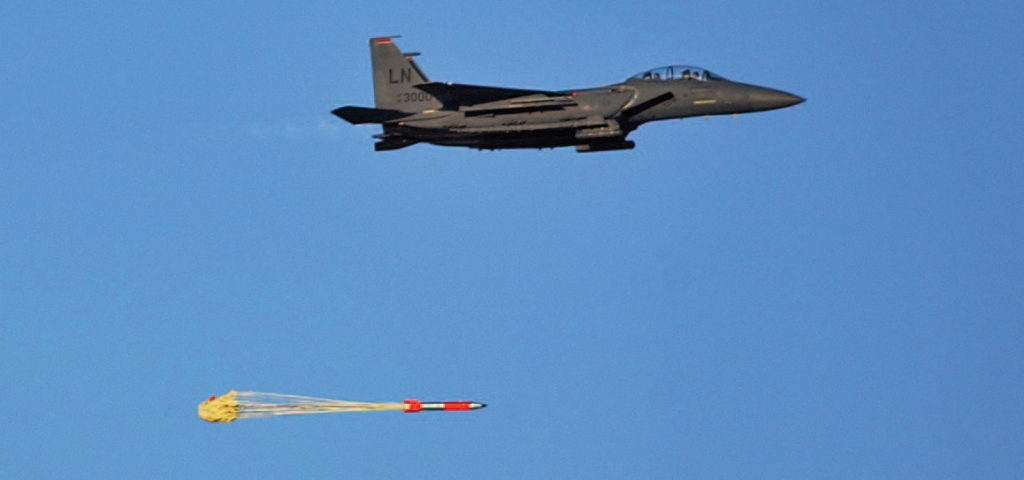
The Steadfast Noon exercise will practice employment of non-strategic nuclear weapons, like this unarmed B61-4 nuclear gravity bomb dropped by an F-15E from the 48th Fighter Wing at RAF Lakenheath. Image: Sandia National Laboratories.
[Updated version] Today, Monday October 17, 2022, the North Atlantic Treaty Organization (NATO) will begin a two-week long exercise in Europe to train aircrews in using U.S. non-strategic nuclear bombs. The exercise, known as Steadfast Noon, is centered at Kleine Brogel Air Base in Belgium, one of six airbases in Europe that store U.S. nuclear bombs. The exercise takes place midst significant modernizations at nuclear bases across Europe.
Steadfast Noon exercises are held once every year, but this year is unique because the exercise will take place during the largest conventional war in Europe since World War II with considerable tension and uncertainty resulting from Russia’s war in Ukraine. Moreover, Steadfast Noon is expected to more or less coincide with a large Russian strategic nuclear exercise. For NATO officials, other than Putin’s war in Ukraine, this is all routine. But for the public, it is but the latest development in rising tensions and unprecedented fears about nuclear war.
According to NATO, Steadfast Noon will involve 14 countries (less than half of the 30 NATO allies) and up to 60 aircraft. That involves fourth-generation F-16s and F-15Es as well as fifth-generation F-35A and F-22 fighter jets. A number of tankers and surveillance aircraft will also take part. Although the exercise is practicing NATO’s non-strategic nuclear forces, a couple of U.S. strategic B-52 bombers will also participate. Training flights will take place over Belgium and the United Kingdom as well as over the North Sea. There might also be flights over Germany and the Netherlands.
Practicing Nuclear Bomb Sharing
The Steadfast Noon exercise will practice a controversial arrangement known as nuclear sharing, under which the United States installs nuclear equipment on fighter jets of select non-nuclear NATO countries and train their pilots to carry out nuclear strike with U.S. nuclear bombs.
The arrangement is controversial because the United States as a party to the nuclear Non-Proliferation Treaty (NPT) has promised not to hand over nuclear weapons to other countries, and the non-nuclear countries in the sharing arrangement have promised not to receive nuclear weapons from the nuclear weapon states. In peacetime the nuclear weapons are under U.S. control, but the arrangement means that they would be handed over to the non-nuclear country in war time. The arrangement was in place before the NPT was signed so it is not a violation of the letter of the treaty. But it can be said to violate the spirit and has been an irritant for years.
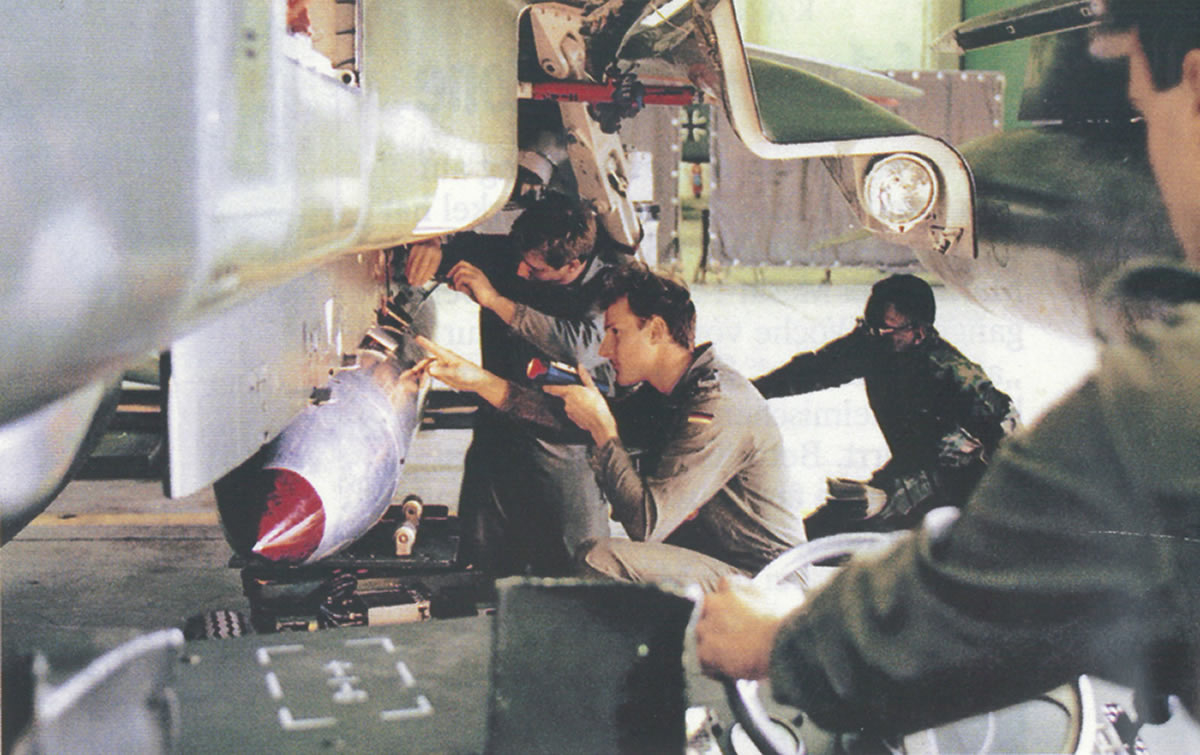
Under supervision by U.S. Air Force personnel, German Air Force personnel is practicing loading of a U.S. B61-4 nuclear bomb shape on a German Tornado fighter jet. In a war, German pilots could be given control of U.S. nuclear bombs. Image: Der Spiegel.
“If NATO was to conduct a nuclear mission in a conflict,” NATO says, “the B-61 [sic] weapons would be carried by certified Allied aircraft…However, a nuclear mission can only be undertaken after explicit political approval is given by NATO’s Nuclear Planning Group (NPG) and authorisation is received from the US President and UK Prime Minister.” It is unclear why the U.K. Prime Minister would have to authorize employment of U.S. nuclear weapons, and unless NATO territory had been attacked with nuclear weapons first, it seems unlikely that the 29 countries in the NPG would be able to agree to approve of employment of non-strategic nuclear weapons from bases in Europe.
NATO disclosed earlier this year that seven NATO countries contribute dual-capable aircraft to the nuclear sharing mission. The countries were not identified but five are widely known: Belgium, Germany, Italy, Netherlands, and the United States. The sixth country is probably Turkey (despite rumors that it was no longer part of the mission), in which case some Turkish F-16s are still equipped to deliver B61 bombs. The seventh country was a mystery, but it turns out it is Greece. Although Greece no longer stores nuclear weapons (they were withdrawn in 2001) and doesn’t have a committed fighter unit, it has a reserve units and a contingency mission. Like other allies (except France), Greece is fully involved in the NPG.]
Nuclear Base Modernizations
During the past several years, the nuclear bases and the infrastructure that support the nuclear sharing mission in Europe have been undergoing significant upgrades, including cables, command and control systems, weapons maintenance and custodial facilities, security perimeters, and runway and tarmac areas.
There are currently six active sites in Europe that store U.S. nuclear bombs: Kleine Brogel air base in Belgium, Büchel air base in Germany, Aviano and Ghedi air bases in Italy, Volkel air base in the Netherlands, and possibly Incirlik in Turkey. The estimated number of weapons at each site is based on the number of active vaults, aircraft, and other information.
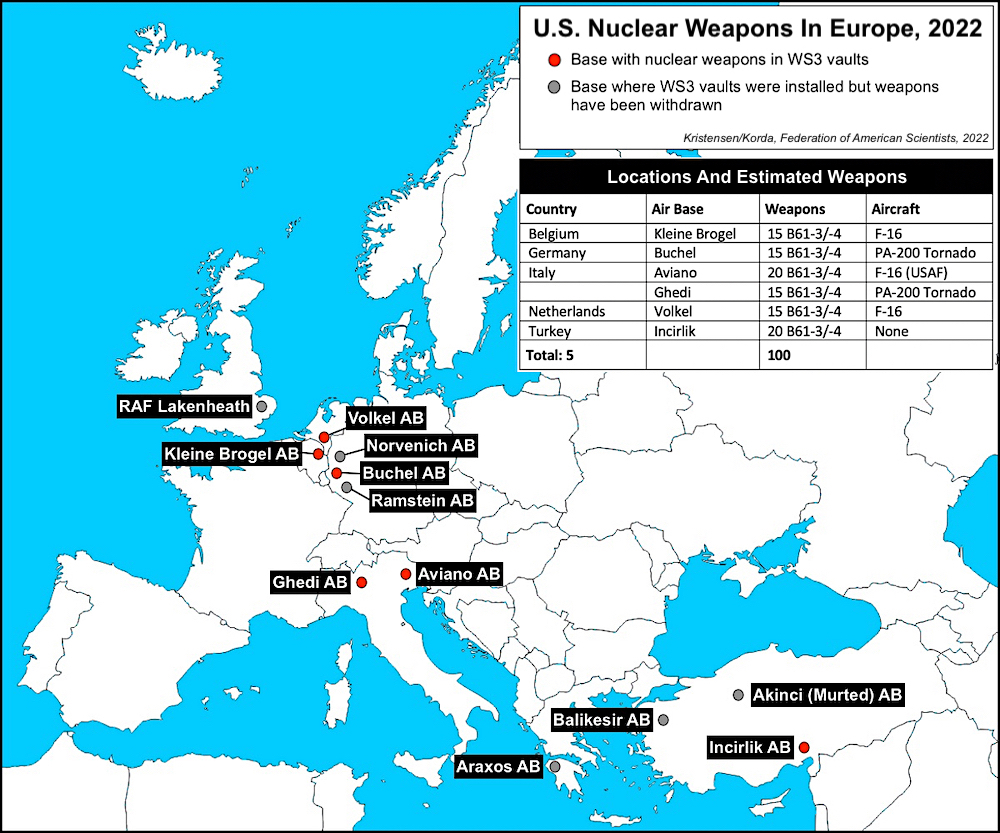
Each of these bases have one or two dozen active vaults (Weapons Storage Security System, WS3) inside as many protective aircraft shelters. Ramstein air base in Germany used to be the largest storage site in Europe but only 7 vaults remain active possibly for training and transfer. All weapons were withdrawn from Lakenheath before 2007 but the United Kingdom was recently added to the nuclear infrastructure storage modernization program, which means there are now eight active WS3 sites in Europe.

The modernizations at the various bases vary depending on capacity, location, and host country. At Kleine Brogel Air Base in Belgium, the host base for the Steadfast Noon exercise this year, the 701st Munition Support Squadron quarters have been significantly expanded with a drive-through facility for nuclear weapons maintenance trucks. Other construction includes a major facility inside the aircraft tarmac perimeter area, a new control tower, and upgrades of underground cables and the Alarm Communication & Display (AC&D) system.
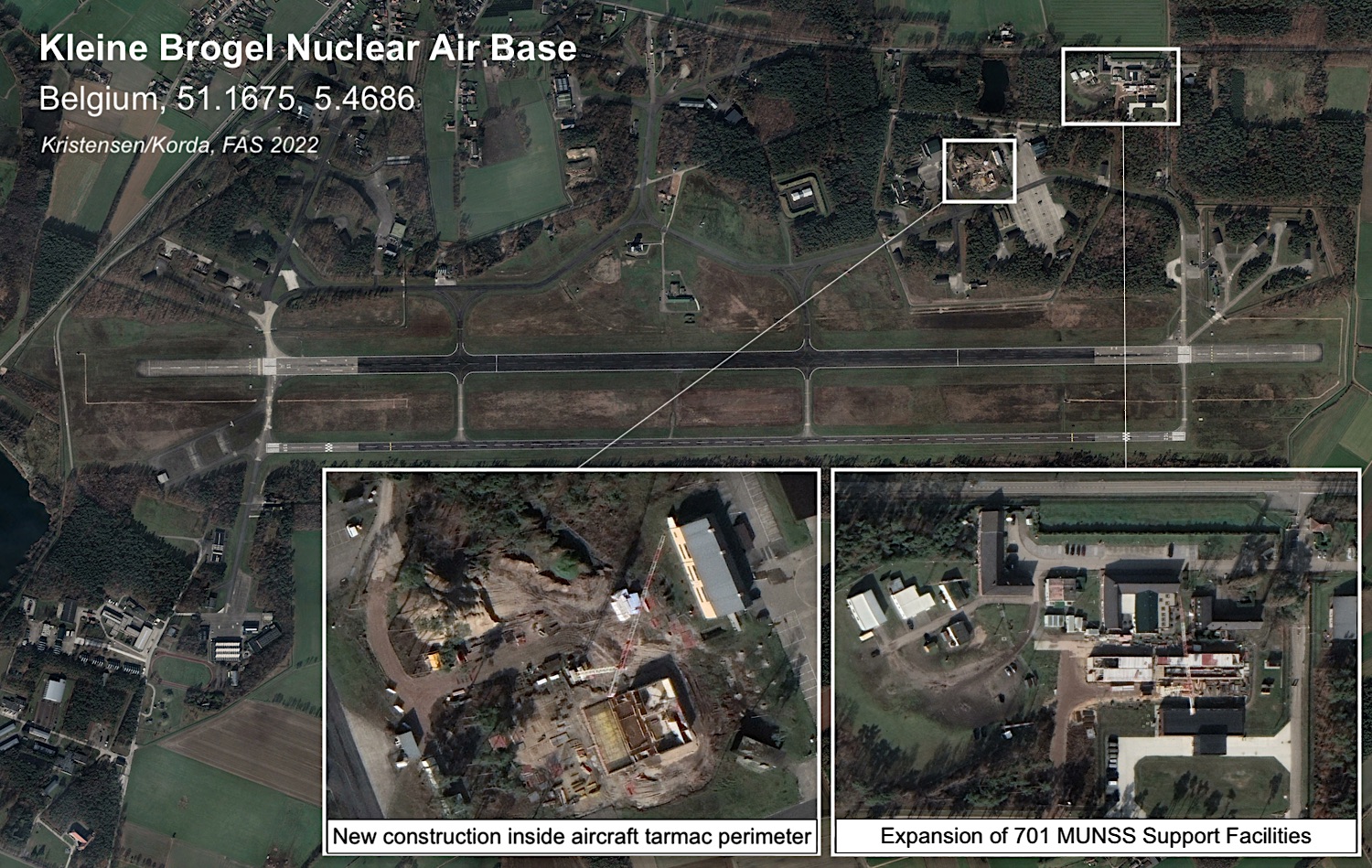
At Büchel Air Base in Germany, construction is underway on the runway. During construction, the Tornados of the 33rd Fighter Wing will be temporarily based at Norvenich Air Base. However, the 10-15 B61 nuclear bombs will remain in the vaults at Büchel. Other recent updates at the base have included underground cables and the Alarm Communication & Display (AC&D) system.
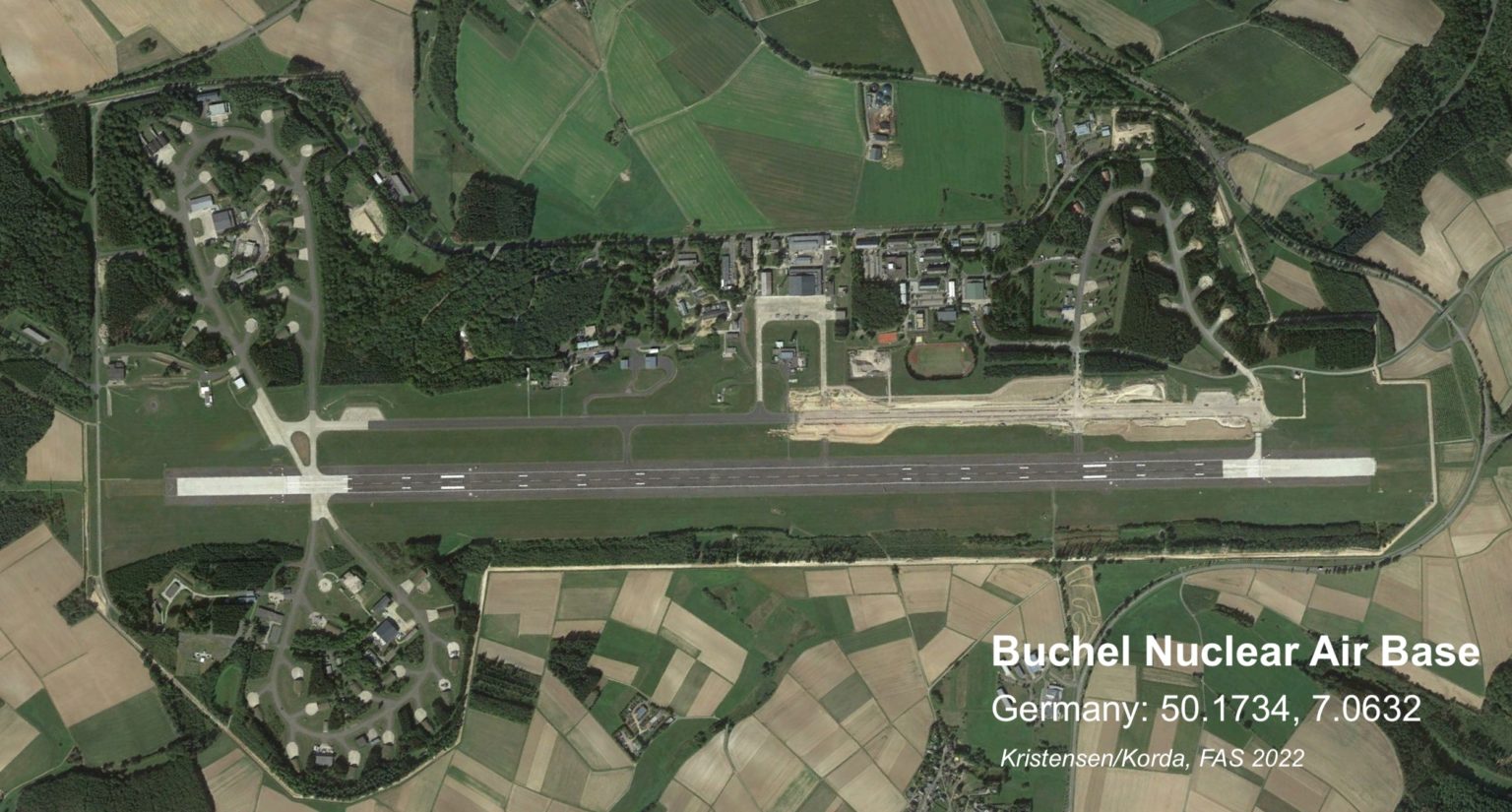
In 2020, as part of a series of visits to bases involved in the nuclear sharing mission, U.S. Air Force Maj. Gen. Derek C. France, the director of operations, strategic deterrence, and integration for U.S. Air Forces in Europe – Air Forces Africa Headquarters director of operations, strategic deterrence, and integration, visited Büchel Air Base where he received a tour and explanation of a protective aircraft shelter. A picture of the tour shows the vault open and a B61 nuclear bomb shape inside.
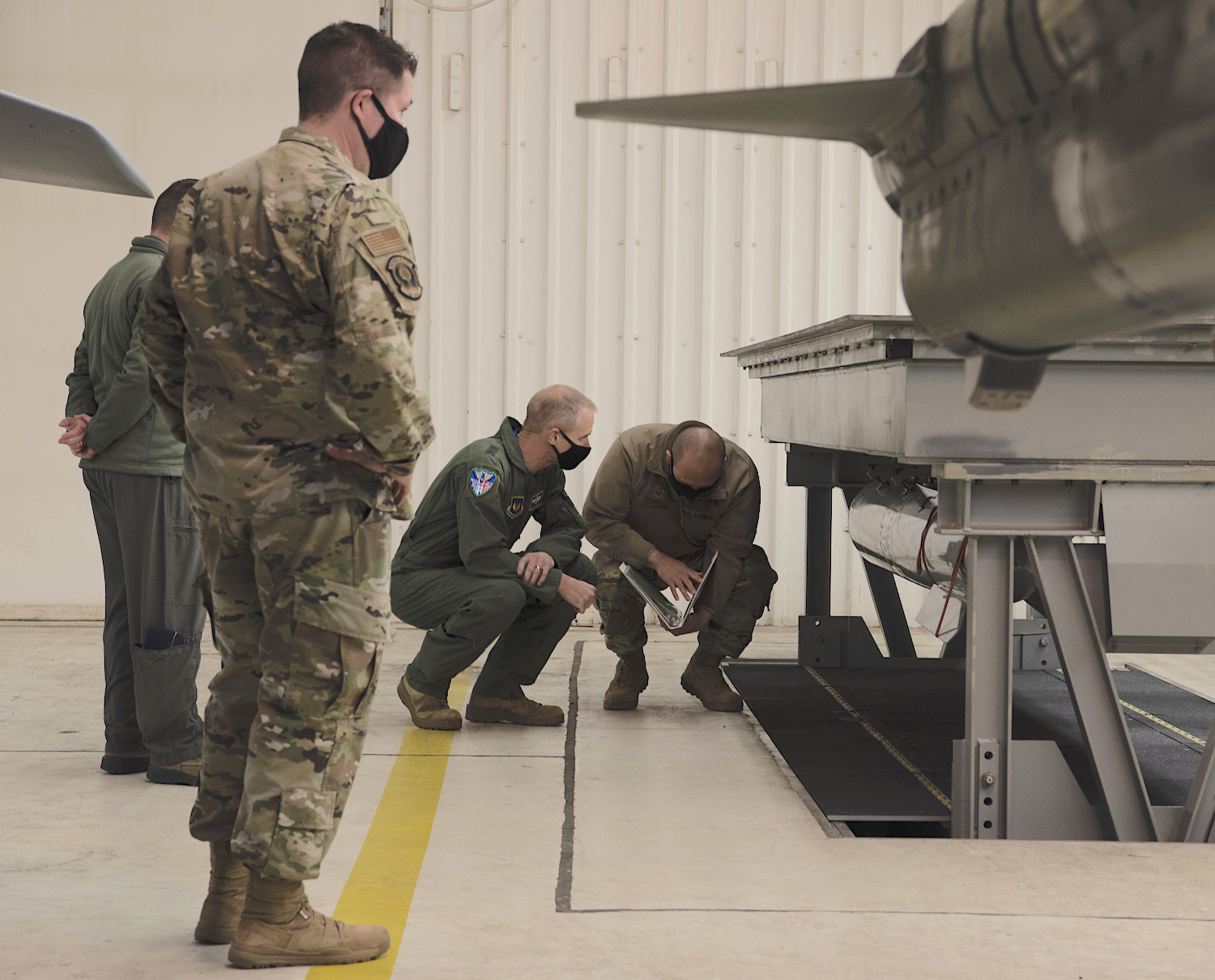
U.S. Air Force Maj. Gen. Derek C. France, U.S. Air Forces in Europe – Air Forces Africa Headquarters director of operations, strategic deterrence, and nuclear integration, received a tour of a Protective Aircraft Shelter at Büchel Air Base on October 15, 2020. The image shows a B61 nuclear bomb shape hanging in the elevated vault.
At Volkel Air Base in the Netherlands, the most visible modernization currently underway is a major new tarmac area. The construction includes security perimeters probably intended to protect the C-17 aircraft that transport weapons and components to and from the base. Other recent construction the base has included burying underground cables and upgrading the Alarm Communication & Display (AC&D) system used for the WS3 vaults.
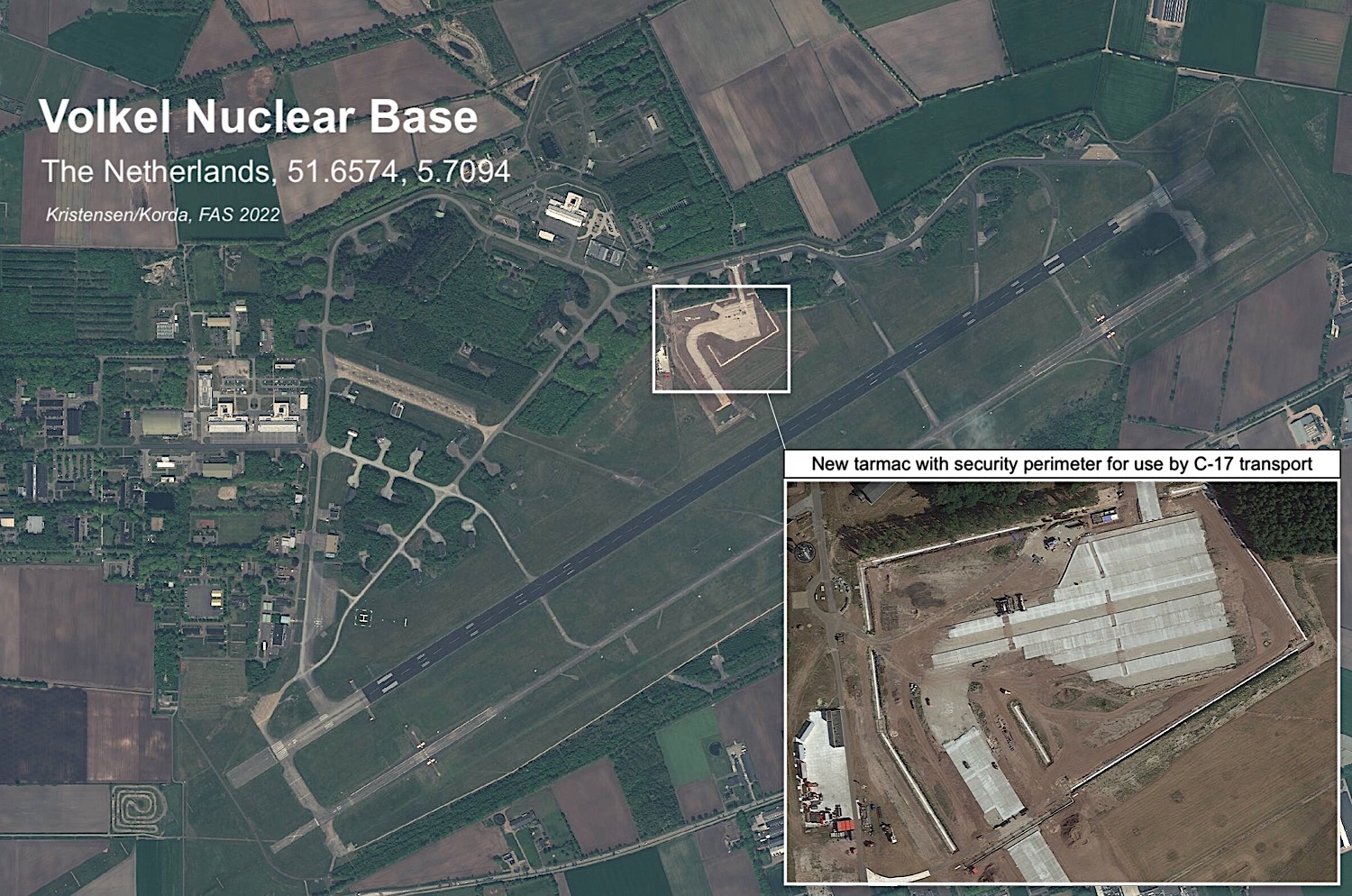
Ghedi Air Base in Italy is undergoing a dramatic upgrade that includes a new tarmac and shelter area for the new F-35A fighter jets that will replace the Tornado jets in the nuclear sharing mission. Work is also underway on what appears to be a drive-through facility for weapons maintenance trucks in the 704th MUNSS area. And a new high-security perimeter has been erected around eight vaults, possibly those of the 11 that are active. This perimeter is similar to perimeters that were constructed at Aviano and Incirlik air bases in 2014-2015. Finally, Ghedi also has received an upgrade of underground cables and the Alarm Communication & Display (AC&D) system used for the WS3 vaults.
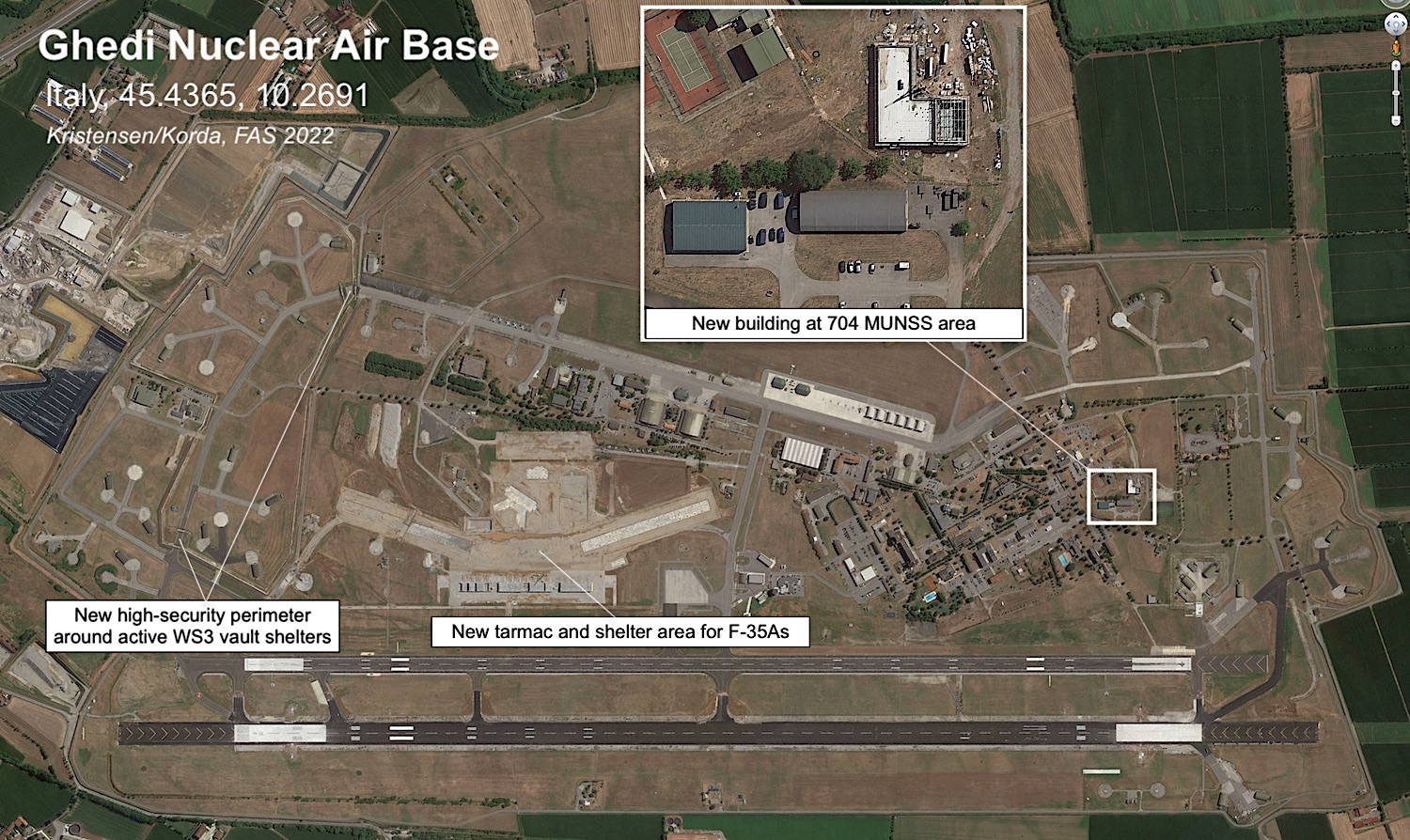
Upgrades of Aviano Air Base in Italy and Incirlik Air Base in Turkey happened around 2015 are described in this article: Upgrades At US Nuclear Bases In Europe Acknowledge Security Risk. Since then, installation of new cables between the nuclear vaults at Incirlik Air Base is visible on satellite images.

Weapons Modernization
In addition to modernization of bases and support facilities, delivery systems and weapons are also being upgraded. Five of the seven countries that contribute dual-capable aircraft to the nuclear sharing mission are upgrading to the F-35A fifth-generation fighter-bomber: Belgium, Germany, Italy, the Netherlands, and the United States. Turkey was scheduled to upgrade to F-35A but lost the contract after it purchased the Russian S-400 system.
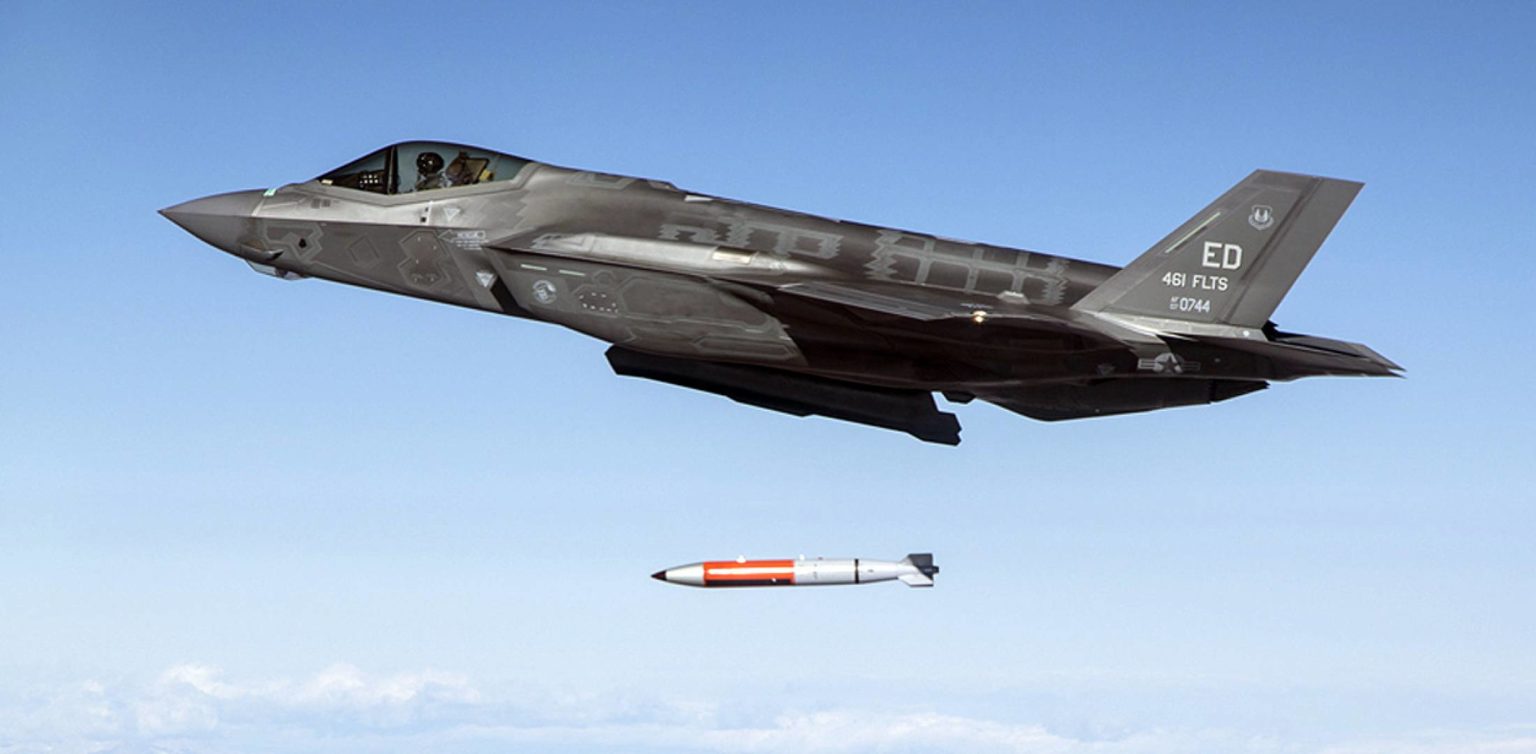
An F-35A test-drops a B61-12 guided nuclear bomb. The enhanced weapon will be compatible with both fighter jets and strategic bombers and begin replacing older B61 versions in Europe from 2023. Image: U.S. Air Force.
Finally, the existing B61 nuclear bombs will soon be replaced by the enhanced B61-12 guided nuclear bomb. Development is essentially complete and full-scale production of about 480 B61-12s is expected to begin soon. The new weapon is thought to have the same yield range as the current B61-4: 0.3, 1.5, 10 and 50 kilotons. Training of the units in Europe to receive the new weapon is scheduled to begin in early-2023 and the first weapons potentially arriving at the first base in late-2023 or 2024.
In addition to the non-strategic fighter jets F-15E, F-16, F-35A, and Tornado, the B61-12 will also be integrated on the B-2 and B-21 strategic bombers. Because of the increased accuracy provided by the tail kit, all the digital aircraft that can make use of it (all except F-16 and Tornado) will be able to hold at risk a wide range of targets. The combination of increased accuracy and lower-yield options on non-strategic and strategic stealth aircraft will significantly increase the capability of the gravity bomb mission.

Each of the WS3 vaults at European bases can hold up to four nuclear bombs. Here crews are practicing loading B61 bombs into a vault: two B61-3/4 bombs on the top rack and two B61-12 bombs on the lower rack. Image: U.S. Air Force, obtained by Joseph Trevithick (The Drive) under FOIA.
This publication was made possible by generous contributions from the John D. and Catherine T. MacArthur Foundation, the New-Land Foundation, the Ploughshares Fund, the Prospect Hill Foundation, Longview Philanthropy, the Stewart R. Mott Foundation, the Future of Life Institute, Open Philanthropy, and individual donors. The statements made and views expressed are solely the responsibility of the author.
New Environmental Assessment Reveals Fascinating Alternatives to Land-Based ICBMs
A new Air Force environmental assessment reveals that it considered basing ICBMs in underground railway tunnels––or possibly underwater.
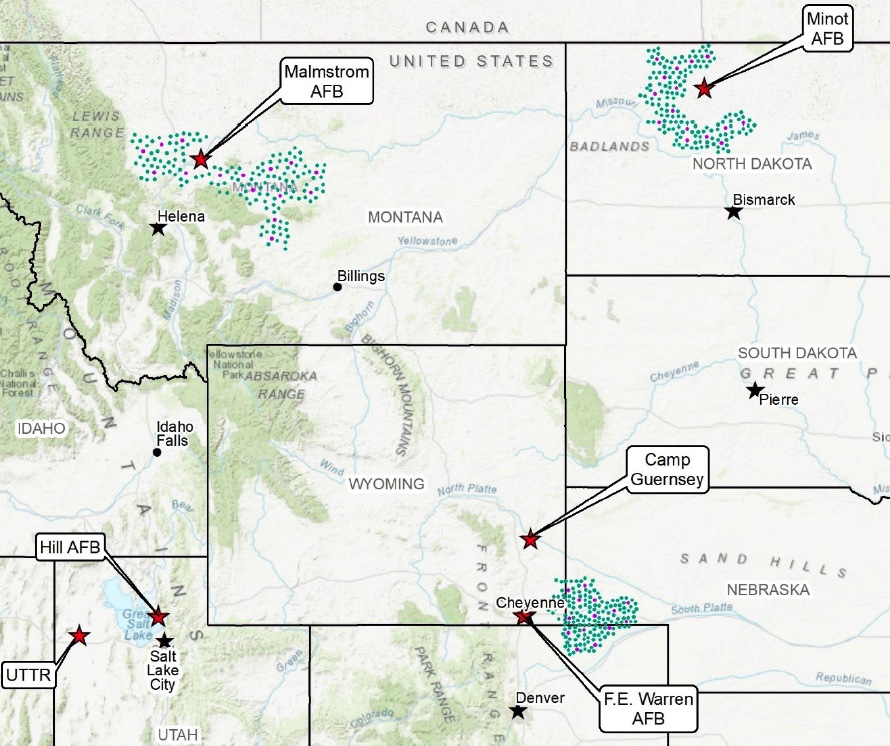
Map of the ICBM missile fields contained within the Air Force’s July 2022 assessment.
On July 1st, the Air Force published its Draft Environmental Impact Statement (EIS) for its proposed ICBM replacement program, previously known as the Ground-Based Strategic Deterrent (GBSD) and now by its new name, “Sentinel.” The government typically conducts an EIS whenever a federal program could potentially disrupt local water supplies, transportation, socioeconomics, geology, air quality, and other related factors.
A comprehensive environmental assessment is certainly warranted in this case, given the tremendous scale of the Sentinel program––which consists of a like-for-like replacement of all 400 Minuteman III missiles that are currently deployed across Colorado, Montana, Nebraska, North Dakota, and Wyoming, plus upgrades to the launch facilities, launch control centers, and other supporting infrastructure.

Cover page of the Air Force’s July 2022 Draft Environmental Impact Statement for the GBSD.
The Draft EIS was anxiously awaited by local stakeholders, chambers of commerce, contractors, residents, and… me! Not because I’m losing sleep about whether Sentinel construction will disturb Wyoming’s Western Bumble Bee (although maybe I should be!), but rather because an EIS is also a wonderful repository for juicy, and often new, details about federal programs––and the Sentinel’s Draft EIS is certainly no exception.
Interestingly, the most exciting new details are not necessarily about what the Air Force is currently planning for the Sentinel, but rather about which ICBM replacement options they previously considered as alternatives to the current program of record. These alternatives were assessed during in the Air Force’s 2014 Analysis of Alternatives––a key document that weighs the risks and benefits of each proposed action––however, that document remains classified. Therefore, until they were recently referenced in the July 2022 Draft EIS, it was not clear to the public what the Air Force was actually assessing as alternatives to the current Sentinel program.
Missile alternatives
The Draft EIS notes that the Air Force assessed four potential missile alternatives to the current plan, which involves designing a completely new ICBM:
- Reproducing Minuteman III ICBMs to “existing specifications” by washing out and refilling the first- and second-stage rocket boosters; remanufacturing the third stages and Propulsion System Rocket Engine––the ICBM’s post-boost vehicle; and refurbishing and replacing all other subsystems;
The Air Force appears to have ultimately eliminated all four of these options from consideration because they did not meet all of their “selection standards,” which included criteria like sustainability, performance, safety, riskiness, and capacity for integration into existing or proposed infrastructure.
Of particular interest, however, is the Air Force’s note that the Minuteman III reproduction alternative was eliminated in part because it did not “meet the required performance criteria for ICBMs in the context of modern and evolving threats (e.g., range, payload, and effectiveness.” It is highly significant to state that the Minuteman III cannot meet the required performance criteria for ICBMs, given that the Minuteman III currently performs the ICBM role for the US Air Force and will continue to do so for the next decade.
This statement also suggests that “modern and evolving threats” are driving the need for an operationally improved ICBM; however, it is unclear what the Air Force is referring to, or how these threats would necessarily justify a brand-new ICBM with new capabilities. As I wrote in my March 2021 report, “Siloed Thinking: A Closer Look at the Ground-Based Strategic Deterrent,”
“With respect to US-centric nuclear deterrence, what has changed since the end of the Cold War? China is slowly but steadily expanding its nuclear arsenal and suite of delivery systems, and North Korea’s nuclear weapons program continues to mature. However, the range and deployment locations of the US ICBM force would force the missiles to fly over Russian territory in the event that they were aimed at Chinese or North Korean targets, thus significantly increasing the risk of using ICBMs to target either country. Moreover, […] other elements of the US nuclear force––especially SSBNs––could be used to accomplish the ICBM force’s mission under a revised nuclear force posture, potentially even faster and in a more flexible manner. […] It is additionally important to note that even if adversarial missile defenses improved significantly, the ability to evade missile defenses lies with the payload––not the missile itself. By the time that an adversary’s interceptor was able to engage a US ICBM in its midcourse phase of flight, the ICBM would have already shed its boosters, deployed its penetration aids, and would be guided solely by its reentry vehicle. Reentry vehicles and missile boosters can be independently upgraded as necessary, meaning that any concerns about adversarial missile defenses could be mitigated by deploying a more advanced payload on a life-extended Minuteman III ICBM.”
Of additional interest is the passage explaining why the Air Force dismissed the possibility of using the Trident II D5 SLBM as a land-based weapon:
“The D5 is a high-accuracy weapon system capable of engaging many targets simultaneously with overall functionality approaching that of land- based missiles. The D5 represents an existing technology, and substantial design and development cost savings would be realized; but the associated savings would not appreciably offset the infrastructure investment requirements (road and bridge enhancements) necessary to make it a land-based weapon system. In addition, motor performance and explosive safety concerns undermine the feasibility of using the D5 as a land-based weapon system.”
The Air Force’s concerns over road and bridge quality are probably justified––missiles are incredibly heavy, and America’s bridges are falling apart at a terrifying rate. However, it is unclear why the Air Force is not confident about the D5’s motor performance, given that even aging Trident SLBMs have performed very well in recent flight tests: in 2015 the Navy conducted a successful Trident flight test using “the oldest 1st stage solid rocket motor flown to date” (over 26 years old), with 2nd and 3rd stage motors that were 22 years old. In January 2021, Vice Admiral Johnny Wolfe Jr.––the Navy’s Director for Strategic Systems Programs––remarked that “solid rocket motors, the age of those we can extend quite a while, we understand that very well.” This is largely due to the Navy’s incorporation of nondestructive testing techniques––which involve sending a probe into the bore to measure the elasticity of the propellant––to evaluate the reliability of their missiles.
As a result, the Navy is not currently contemplating the purchase of a brand-new missile to replace its current arsenal of Trident SLBMs, and instead plans to conduct a second life-extension to keep them in service until 2084. However, the Air Force’s comments suggest either a lack of confidence in this approach, or perhaps an institutional preference towards developing an entirely new missile system. [Note: Amy Woolf helpfully offered up another possible explanation, that the Air Force’s concerns could be related to the ability of the Trident SLBM’s cold launch system to perform effectively on land, given that these very different launch conditions could place additional stress on the missile system itself.]
Basing alternatives
The Draft EIS also notes that the Air Force assessed two fascinating––and somewhat familiar––alternatives for basing the new missiles: in underground tunnels and in “deep-lake silos.”
The tunnel option––which had been teased in previous programmatic documents but never explained in detail––would include “locating, designing, excavating, developing, and installing critical support infrastructure such as rail systems and [launch facilities] for an array of underground tunnels that would likely span hundreds of miles”––and it is effectively a mashup of two concepts from the late Cold War.
The rail concept was strongly considered during the development of the MX missile in the 1980s, although the plan called for missile trains to be dispersed onto the country’s existing civilian rail network, rather than into newly-built underground tunnels. Both the rail and tunnel concepts were referenced in one of my favourite Pentagon reports––a December 1980 Pentagon study called “ICBM Basing Options,” which considered 30 distinct and often bizarre ICBM basing options, including dirigibles, barges, seaplanes, and even hovercraft!

Illustrations of “Commercial Rail” concept from 1980 Pentagon report, “ICBM Basing Options.”
The second option––basing ICBMs in deep-lake silos––was also referenced in that same December 1980 study. The concept––nicknamed “Hydra”––proposed dispersing missiles across the ocean using floating silos, with “only an inconspicuous part of the missile front end [being] visible above the surface.” Interestingly, this raises the theoretical question of whether the Air Force would still maintain control over the ICBM mission, given that the missiles would be underwater.

Illustration of “Hydra” concept from 1980 Pentagon report, “ICBM Basing Options.”
When considering alternative basing modes for the Sentinel ICBM, the Air Force eliminated both concepts due to cost prohibitions, and, in the case of underwater basing, a lack of confidence that the missiles would be safe and secure. This concern was also floated in the 1980 study as well, with the Pentagon acknowledging the likelihood that US adversaries and non-state actors “would also be engaged in a hunt for the Hydras. Not under our direct control, any missile can be destroyed or towed away (stolen) at leisure.”
Another potential option?
In addition to revealing these fascinating details about previously considered alternatives to the Sentinel program, the Draft EIS also highlighted a public comment suggesting that “the most environmentally responsible option” would simply be the reduction of the Minuteman III inventory.
The Air Force rejected the comment because it says that it is “required by law to accelerate the development, procurement, and fielding of the ground based strategic deterrent program;’” however, the public commenter’s suggestion is certainly a reasonable one. The current force level of 400 deployed ICBMs is not––and has never been––a magic number, and it could be reduced further for a variety of reasons, including those related to security, economics, or a good faith effort to reduce deployed US nuclear forces. In particular, as George Perkovich and Pranay Vaddi wrote in a 2021 Carnegie Endowment for International Peace report, “This assumption that the ICBM force would not be eliminated or reduced before 2075 is difficult to reconcile with U.S. disarmament obligations under Article VI of the Nuclear Non-Proliferation Treaty.”
The security environment of the 21st century is already very different than that of the previous century. The greatest threats to Americans’ collective safety are non-militarized, global phenomena like climate change, domestic unrest and inequality, and public health crises. And recent polling efforts by ReThink Media, the Union of Concerned Scientists, and the Federation of American Scientists suggest that Americans overwhelmingly want the government to invest in more proximate social issues, rather than on nuclear weapons. To that end, rather than considering building new missile tunnels, it would likely be much more domestically popular to spend money on domestic priorities––perhaps new subway tunnels?
—
Background Information:
- “Siloed Thinking: A Closer Look at the Ground-Based Strategic Deterrent,” Federation of American Scientists (Mar. 2021)
- “Environmental Assessment Reveals New Details About the Air Force’s ICBM Replacement Plan,” Federation of American Scientists (Nov. 2020)
- ICBM Information Project, Federation of American Scientists
This publication was made possible by generous support from the John D. and Catherine T. MacArthur Foundation, the New-Land Foundation, Ploughshares Fund, the Prospect Hill Foundation, and Longview Philanthropy. The statements made and views expressed are solely the responsibility of the author.
Lakenheath Air Base Added To Nuclear Weapons Storage Site Upgrades
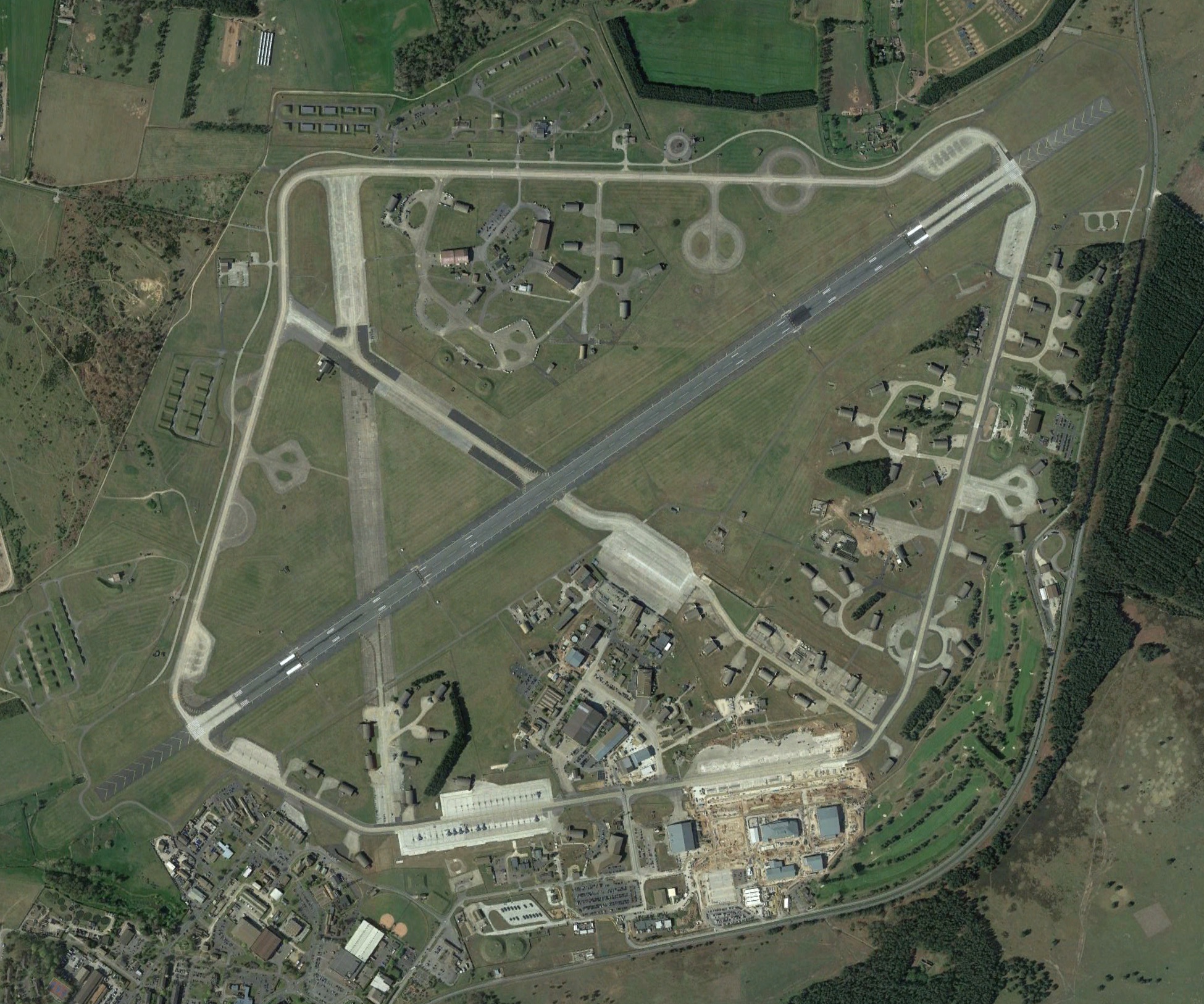
The US Air Force base at Lakenheath has been added to the list of nuclear weapons storage sites being upgraded in Europe.
US Defense Department documents show that NATO has quietly added the United Kingdom to the list of nuclear weapons storage locations that are being upgraded.
The documents do not identify the specific facility, but it is believed to be the US Air Base at RAF Lakenheath in southeast England approximately 100 kilometers northeast of London.
Previous budget documents listed “special weapons” storage sites in Belgium, Germany, Italy, the Netherlands, and Turkey as receiving upgrades under a 13-year NATO investment program. The Biden administration’s FY2023 defense budget request adds “the UK” to the list (see image below).
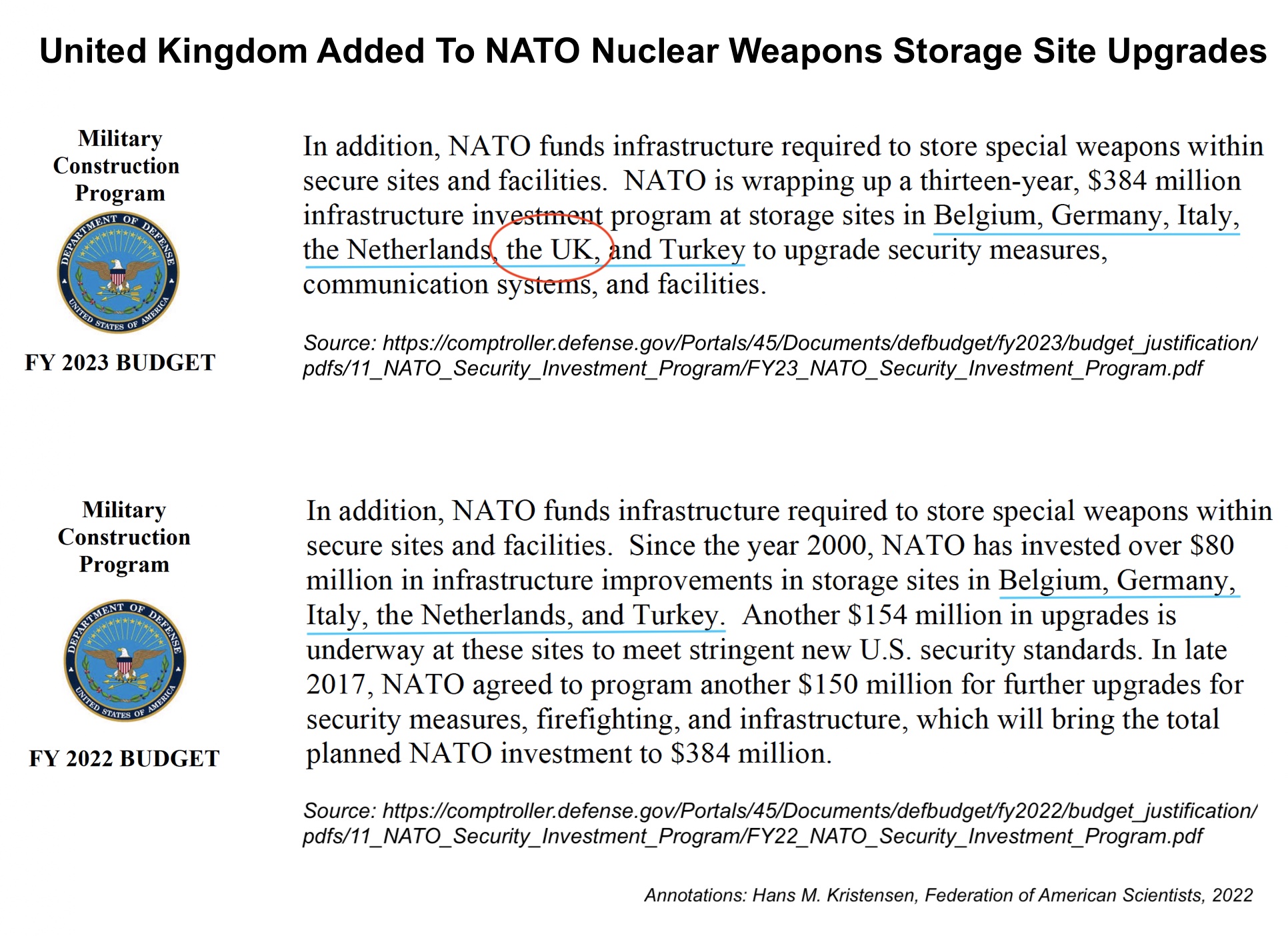
The United Kingdom has been added to the list of nuclear weapons storage site locations in Europe. Click on image to view full size.
RAF Lakenheath was not on the list of “active sites” in the 2016 contract for the upgrade of the nuclear weapons storage site in Europe. The budget documents indicate the base has since been added to the list.
The US Air Force used to store nuclear gravity bombs at Lakenheath, which in the 1990s was equipped with 33 underground storage vaults. By the early 2000s, there were a total of 110 B61 gravity bombs in the vaults for delivery by F-15E aircraft of the 48th Fighter Wing.
In 2008, I disclosed that the nuclear weapons had been withdrawn from RAF Lakenheath, the first time since 1954 that the United States did not store nuclear weapons in the United Kingdom.
What’s Going On?
The addition of the United Kingdom to the list of nuclear storage locations being upgraded in Europe signals a change in the nuclear status of RAF Lakenheath. It is unclear if nuclear weapons have been returned to the base yet or NATO is upgrading the base to be capable of receiving nuclear weapons in the future if necessary.
After nuclear weapons were withdrawn nearly two decades ago, the empty storage vaults were kept in caretaker status. The F-15Es fighter-bombers retained their nuclear capability but at a lower operational level. In recent years there have been rumors about nuclear exercises at the base.
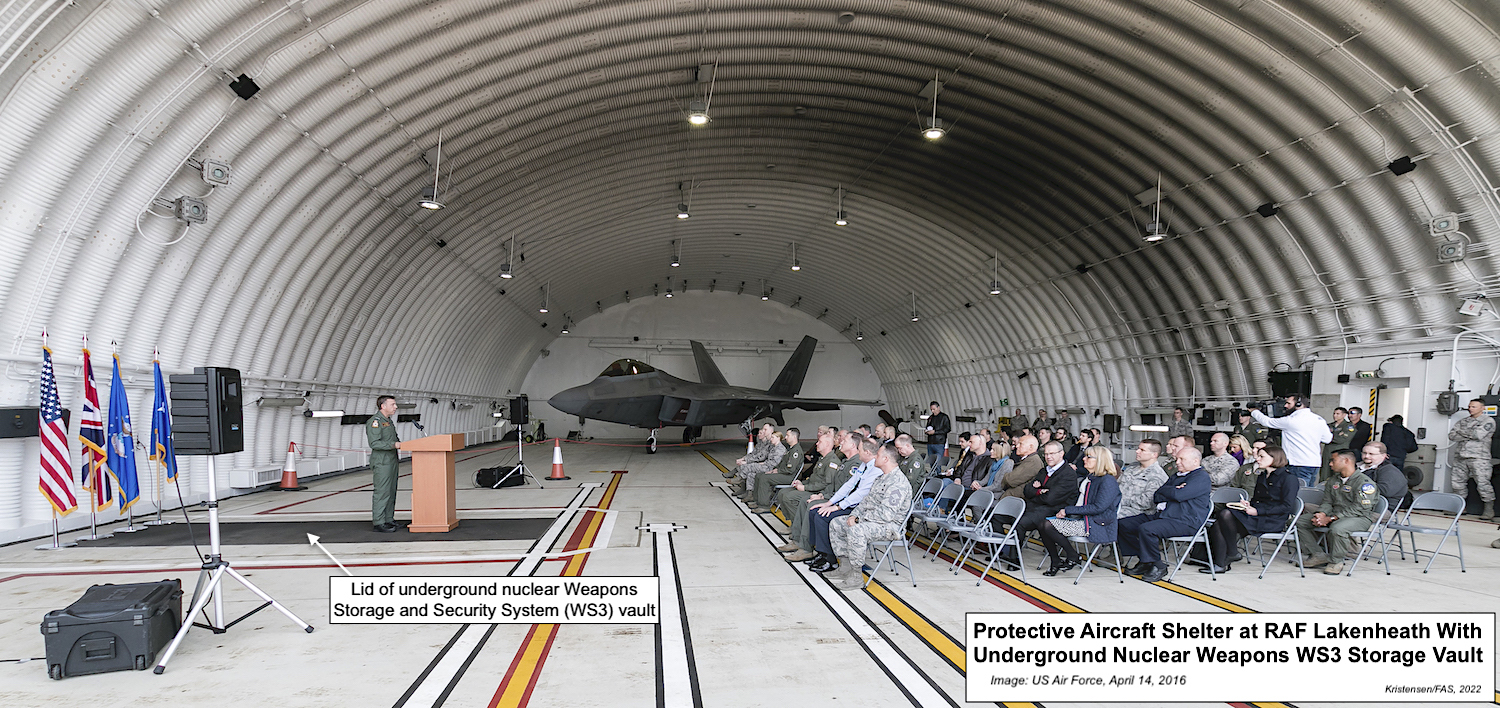
A ceremony during a F-22 Raptor visit to RAF Lakenheath in 2016 was held inside an aircraft shelter with an (empty) underground nuclear weapons vault. There are 33 vaults at the base.
The nuclear upgrade comes as RAF Lakenheath is preparing to become the first US Air Force base in Europe equipped with the nuclear-capable F-35A Lightning. The first of the fifth-generation fighter-bombers arrived in December 2021. A total of 24 F-35As will form the 495th Fighter Squadron of the 48th Fighter Wing at the base.
The US Air Force is scheduled to begin training the nuclear units in Europe within the next year to receive the new B61-12 guided nuclear bomb that will begin full-scale production next month. It is possible the first B61-12 bombs will be shipped to Europe in 2023, where they will replace the B61-3/-4 bombs currently deployed there.

The US will begin full-scale production of the new B61-12 guided nuclear bomb next month, start training units in Europe around the turn of the year, and potentially deploy the first weapons in 2023.
Given NATO’s cautious nuclear response to Russia’s nuclear saber rattling at the start of its invasion of Ukraine, it would be odd if the nuclear upgrade at RAF Lakenheath reflected plans to deploy additional US nuclear bombs to Europe. FAS estimates there currently are roughly 100 nuclear bombs deployed at six air bases in five European countries.
NATO Secretary General Jens Stoltenberg declared in December 2021, that “we have no plans of stationing any nuclear weapons in any other countries than we already have these nuclear weapons as part of our deterrence and that… have been there for many, many years.” Unless NATO has changed its plans since, that seems to be a clear signal that there are currently no plans to deploy nuclear weapons to RAF Lakenheath for now (see map below).

RAF Lakenheath has been an inactive nuclear weapons storage site for nearly two decades. There are currently an estimated 100 US Air Force nuclear bombs stored in Europe.
Rather, the upgrade at RAF Lakenheath could potentially be intended to increase the flexibility of the existing nuclear deployment within Europe, without increasing the number of weapons. Adding RAF Lakenheath as an active site would potentially allow it to receive nuclear weapons from other existing locations in Europe, if that became necessary. Such a contingency could potentially involve receiving weapons withdrawn from Turkey. There are unconfirmed rumors that many of the weapons at Incirlik Air Base in Turkey have already been withdrawn and moved to other bases in Europe.
Readying RAF Lakenheath could potentially also be intended to better realign the overall nuclear posture in Europe with the rapidly deteriorating relations with Russia. This is a delicate issue because changes in NATO’s nuclear posture in Europe might trigger retaliatory changes in Russia’s nuclear posture, including potentially deployment of nuclear weapons to Belarus, which recently changed its constitution to allow for just that.
This publication was made possible by generous support from the John D. and Catherine T. MacArthur Foundation, the New Land Foundation, the Ploughshares Fund, and the Prospect Hill Foundation. The statements made and views expressed are solely the responsibility of the author.
Amidst Nuclear Saber Rattling, New START Treaty Demonstrates Importance
Shortly after Russian military forces invaded Ukraine and President Vladimir Putin said that he had ordered Russian nuclear forces on high combat alert – apparently to deter the United States from getting directly involved, and the United States condemned the statement as “unacceptable” nuclear saber rattling but refused to respond in kind, the two vehemently opposed countries did something amazing: They exchanged factual information about the status of their strategic nuclear forces as required under the New START Treaty.
Yesterday, the US State Department published the unclassified bits of that data exchange. It shows that both countries were below the limits set by the treaty for deployed strategic nuclear forces: 1,550 warheads attributed to 700 deployed long-range ballistic missiles and heavy bombers.
At a time when direct contacts are being curtailed, antagonism runs high, and trust completely lost, it is nothing short of amazing that Russia and the United States continue to abide by the New START treaty and exchange classified information as if nothing had happened.
The reason is clear. Despite their differences, they both have a keen interest in keeping the other country’s long-range nuclear forces in check.
Both the United States and Russia have far more nuclear warheads in their total military stockpiles than what they deploy on their launchers under New START. If the treaty fell away, each side could dramatically and quickly increase the number of nuclear warheads ready to launch on short notice. The US has close to 2,000 strategic warheads in storage, Russia about half that many. Such an increase would be extraordinarily destabilizing and dangerous, especially with a full-scale war raging in Europe and Russia buckling under the strain of unprecedented sanctions.
What the Data Shows

The latest set of data shows that as of March 1, 2022, the United States and Russia both were in compliance with their obligations under the New START treaty not to operate more than 800 total strategic launchers, no more than 700 deployed strategic launchers, and no more than 1,550 warheads attributed to those deployed launchers.
Combined the two countries possessed a total of 1,561 accountable strategic missiles and heavy bombers, of which 1,212 launchers were deployed with 2,989 attributable warheads. That is a slight increase in the number of deployed launchers and warheads compared with six months ago (note: the combined warhead number is actually about 100 too high because each deployed bomber is counted as one weapon even though neither country’s bombers carry weapons under normal circumstances).
Compared with September 2021, the data shows the two countries combined increased the total number of strategic launchers by 19, increased combined deployed strategic launchers by 20, and increased the combined deployed strategic warheads by 142. Of these numbers, only the “19” is real; the other changes reflect natural fluctuations as launchers move in and out of maintenance or are being upgraded.
In terms of the total effect of the treaty, the data shows the two countries since February 2011 combined have cut 428 strategic launchers from their arsenals, reduced deployed strategic launchers by 191, and reduced the number of deployed strategic warheads by 348. However, it is important to remind that this warhead reduction is but a fraction (just over 4 percent) of the estimated 8,185 warheads that remain in the two countries combined nuclear weapons stockpiles (just over 3 percent if counting their total combined inventories of 11,405 stockpiled and retired (but yet to be dismantled) warheads).
The United States
The data shows the United States possessing 800 strategic launchers, exactly the maximum number allowed by the treaty, of which 686 are deployed with 1,515 warheads attributed to them. This is an increase of 21 deployed strategic launchers and 126 deployed strategic warheads over the past 6 months. The increase is probably partly due to the 13th SSBN – the USS Wyoming (SSBN-742) – having completed its reactor refueling overhaul. The 1,515 deployed warheads is the highest number the United States has deployed since September 2015. The total inventory of strategic launchers has not declined since 2017.
The aggregate data does not reveal how many warheads are attributed to the three legs of the triad. The full unclassified data set will be released later this summer. But if one assumes the number of deployed bombers and deployed ICBMs are the same as in the September 2021 data, then the SSBNs carry 1,068 warheads on roughly 220 deployed Trident II SLBMs. That is an increase of 123 warheads on the SSBN force compared with September, or an average of 4-5 warheads per deployed missile. Overall, this accounts for roughly 70 percent of all the 1,515 warheads attributed to the deployed strategic launchers (nearly 73 percent if excluding the “fake” 45 bomber weapons included in the official count).
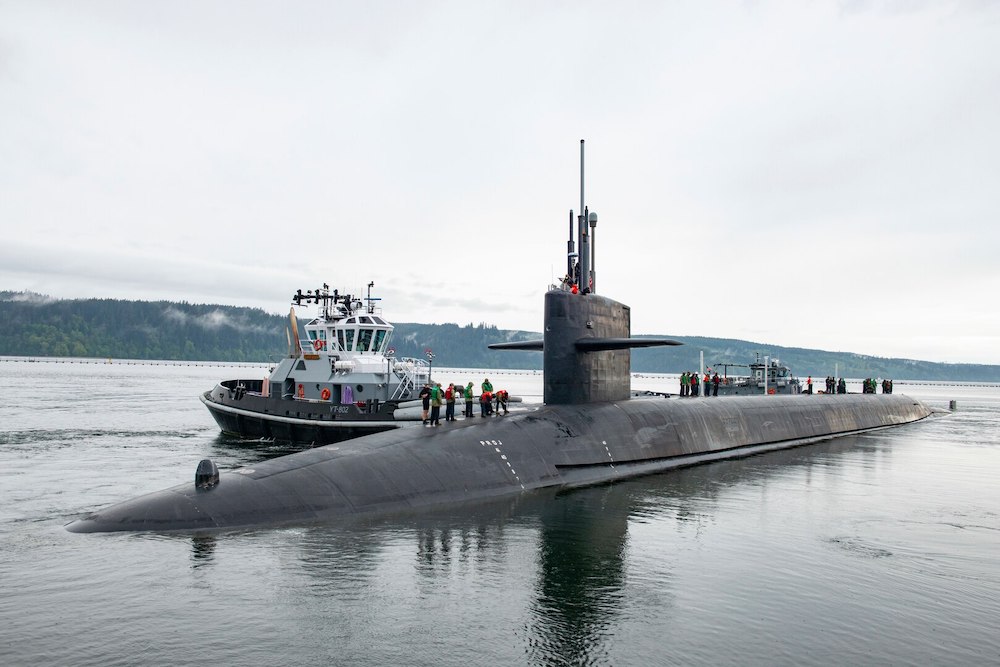
The New START data indicates that the United States as of March 1, 2022 deployed approximately 1,068 warheads on ballistic missile onboard its strategic submarines.
Compared with February 2011, the United States has reduced its total inventory of strategic launchers by 324, deployed launchers by 196, and deployed strategic warheads by 285. While important, the warhead reduction represents only a small fraction (about 8 percent) of the estimated 3,708 warheads that remain in the U.S. stockpile (just over 5 percent if counting total inventory of 5,428 stockpiled and retired (but yet to be dismantled) warheads).
The Russian Federation
The New START data shows Russia with an inventory of 761 strategic launchers, of which 526 are deployed with 1,474 warheads attributed to them. Compared with six months ago, this is a decrease of 1 deployed launcher and an increase of 16 deployed strategic warheads. The change reflects fluctuations caused by launcher maintenance and upgrade work to new systems.
Compared with February 2011, Russia has cut its total inventory of strategic launchers by 104, increased deployed launchers by 5, and decreased deployed strategic warheads by 63. This modest warhead reduction represents less than 2 percent of the estimated 4,477 warheads that remain in Russia’s nuclear weapons stockpile (roughly 1 percent if counting the total inventory of 5,977 stockpiled and retired (but yet to be dismantled) warheads).
The Russian New START reductions since 2011 are smaller than the US reductions because Russia had fewer strategic forces than the United States when the treaty entered into force.
That disparity remains today. Despite frequent claims by hardliners that Russia is ahead of the United States, the New START data shows that Russia has 160 deployed strategic launchers fewer than the United States, a significant gap that exceeds the number of missiles in an entire US Air Force ICBM wing. Despite its nuclear modernization program, Russia has so far not sought to reduce this gap by deploying more strategic launchers. Instead, the Russian launcher deficit has been increasing by about one-third since its lowest point in February 2018.
Instead of closing the launcher gap, the Russian military appears to try to compensate by increasing the number of warheads that can be carried on the newer missiles (SS-27 Mod 2, Yars, and SS-N-32, Bulava) that are replacing older types (SS-25, Topol, SS-N-18, Vysota, and SS-N-23, Sineva). Thanks to the New START treaty limit, many of these warheads are not deployed on the missiles under normal circumstance but are stored and could potentially be uploaded onto the launchers in a crisis. The United States also has such an upload capability for its larger inventory of launchers and therefore is not at a strategic disadvantage.
Two of Russia’s new strategic nuclear weapons (SS-19 Mod 4, Avangard, and SS-29, Sarmat) are covered by New START if formally incorporated. Other types (the Poseidon nuclear-powered torpedo, and the Burevestnik nuclear-powered ground-launched cruise missile) are not yet deployed and appear to be planned in relatively small numbers. They do not appear capable of upsetting the strategic balance in the foreseeable future. The treaty includes provisions for including new weapon types, if the two sides agree.
The sanctions in reaction to Russia’s invasion of Ukraine will likely slow Russia’s nuclear modernization in the next decade.
Inspections and Notifications
In addition to the aggregate data described above, the New START treaty also allows for up to 18 on-site inspections per year and notifications of launcher movements and activities. Up until April 2020, a total of 328 on-site inspections were conducted. Because of COVID-19, there have been no inspections since. The two countries have continued to exchange large numbers of notifications: a total of 23,559 as of March 31, 2022.
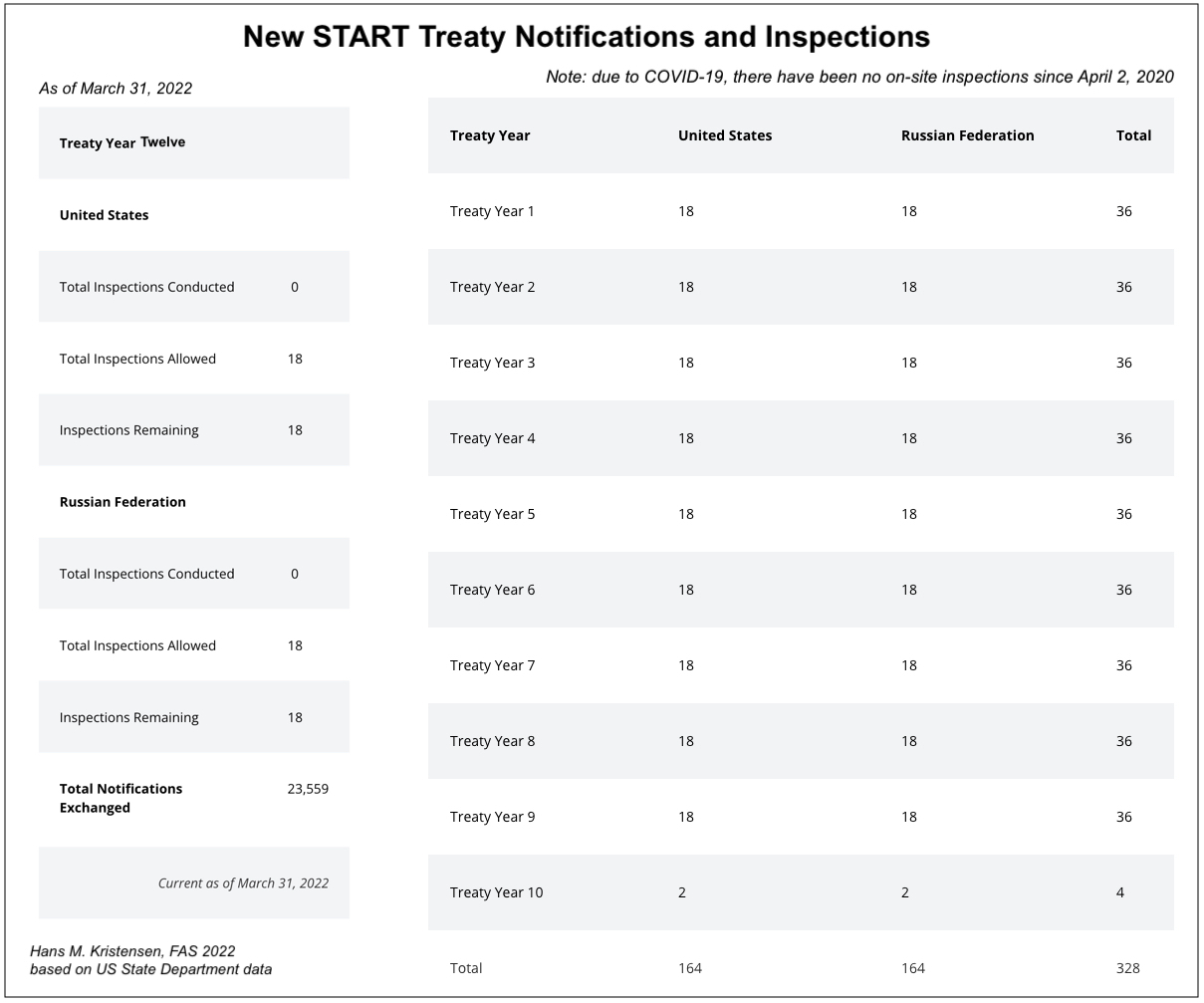
Looking Ahead
The continued complaince by the United States and Russia to the New START treaty and its data exchanges are extraordinary given the demise of treaties, agreements, and deep animosity and almost complete loss of trust. The treaty’s interactions between the two countries and the caps and predictability it provides on strategic offensive nuclear forces have never been more important since New START was negotiated more than a decade ago.
But the clock is running out. Although New START was extended in February 2021 for an additional five years, the treaty will expire in February 2026. Strategic stability talks between Russia and the United States have been disrupted by the war in Ukraine and seem unlikely to resume in the foreseeable future.
If New START is not followed by a new treaty by the time it expires in 2026, there will no limits on US and Russian nuclear forces for the first time the 1970s.
Moreover, political polarization makes it highly uncertain if the US Congress would approve a new treaty.
Short of a formal treaty, the two sides potentially could make an executive agreement and pledge to continue to abide by the New START limits even after the treaty officially expires.
The silver lining is that both countries have a strong interest in continuing to maintain limits on the other side’s strategic offensive nuclear forces. That is why it is important that hardliners are not allowed to misuse Russia’s invasion of Ukraine and China’s nuclear buildup to undermine New START and increase nuclear forces.
Additional information:
- Status of World Nuclear Forces
- Russian nuclear forces, 2022
- United States nuclear forces, 2021 [2022 version forthcoming]
This publication was made possible by generous support from the John D. and Catherine T. MacArthur Foundation, the New Land Foundation, the Ploughshares Fund, and the Prospect Hill Foundation. The statements made and views expressed are solely the responsibility of the author.
Flying Under The Radar: A Missile Accident in South Asia
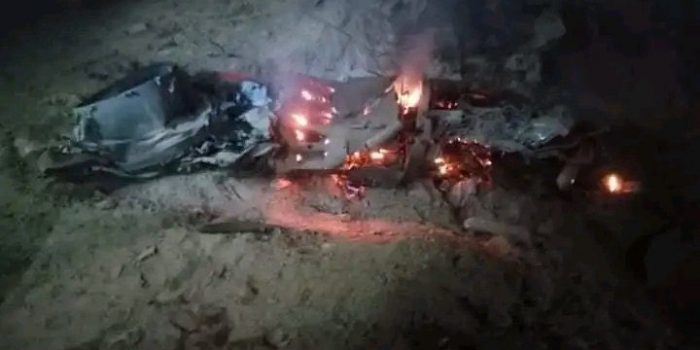
A crashed Indian missile inside Pakistani territory. Image: Pakistan Air Force.
With all eyes turned towards Ukraine these past weeks, it was easy to miss what was almost certainly a historical first: a nuclear-armed state accidentally launching a missile at another nuclear-armed state.*
On the evening of March 9th, during what India subsequently called “routine maintenance and inspection,” a missile was accidentally launched into the territory of Pakistan and impacted near the town of Mian Channu, slightly more than 100 kilometers west of the India-Pakistan border.
Because much of the world’s attention has understandably been focused on Eastern Europe, this story is not getting the attention that it deserves. However, it warrants very serious scrutiny––not only due to the bizarre nature of the accident itself, but also because both India’s and Pakistan’s reactions to the incident reveal that crisis stability between South Asia’s two nuclear rivals may be much less stable than previously believed.
The Incident
Using official statements and open-source clues, it is possible to piece together a relatively complete picture of what took place on the evening of March 9th.
At 18:43:43 Pakistan Standard Time (19:13:43 India Standard Time), the Pakistan Air Force picked up a “high-speed flying object” 104 kilometers inside Indian territory, near Sirsa, in the state of Haryana. According Air Vice Marshal Tariq Zia––the Director General Public Relations for the Pakistan Air Force––the object traveled in a southwesterly direction at a speed between Mach 2.5 and Mach 3. After traveling between 70 and 80 kilometers, the object turned northwest and crossed the India-Pakistan border at 18:46:45 PKT. The object then continued on the same northwesterly trajectory until it crashed near the Pakistani town of Mian Channu at 18:50:29 PKT.
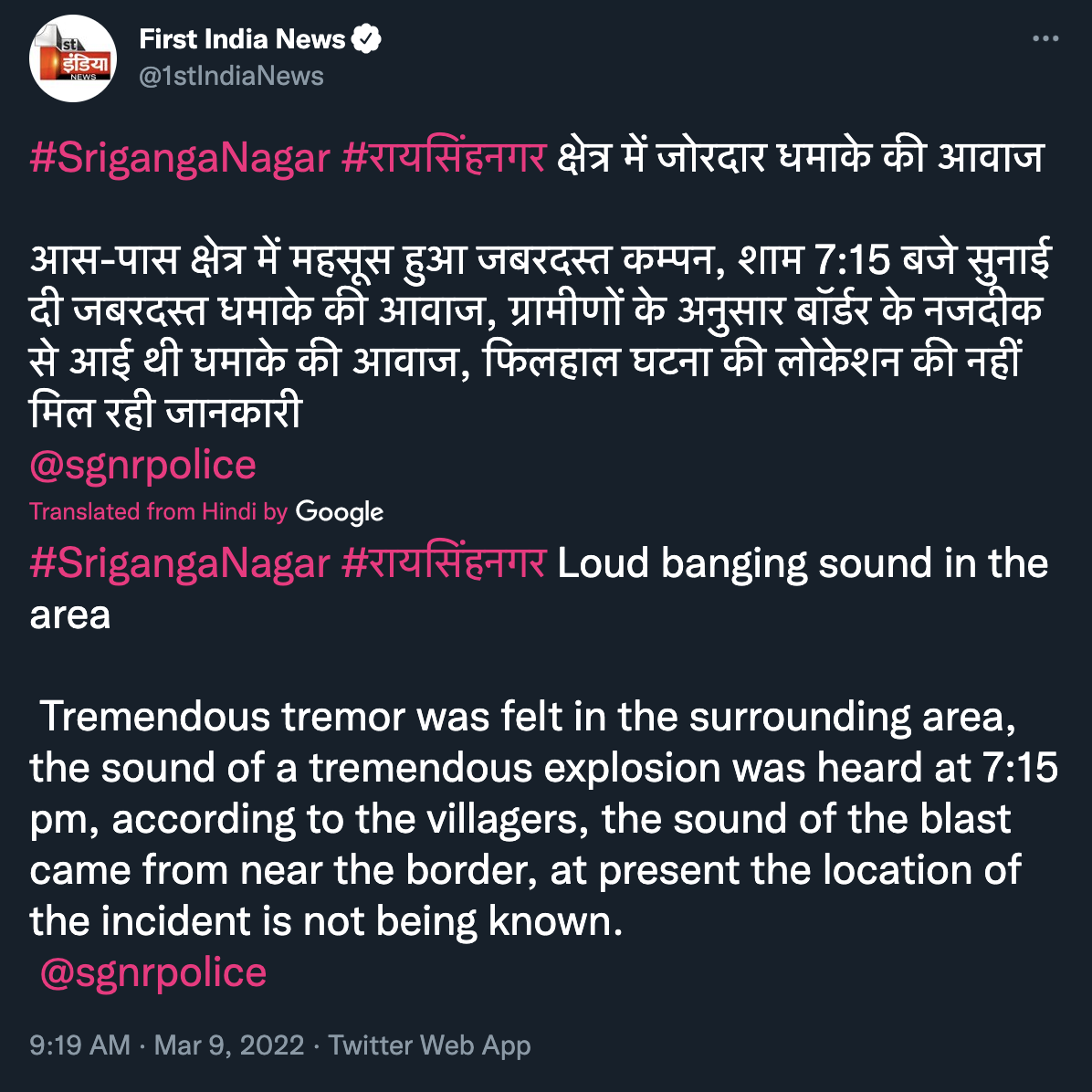
Tweet from @1stIndiaNews indicating that a “tremendous explosion” was heard at approximately 19:15 IST at the city of Sri Ganganagar near the India-Pakistan border. This time and location adds a data point to interpreting the flight path of the missile.
According to Pakistani military officials in a March 10th press conference, 3 minutes and 46 seconds of the object’s total flight time of 6 minutes and 46 seconds were within Pakistani airspace, and the total distance traveled inside of Pakistan was 124 kilometers.

Annotated map of the missile’s flight path provided by Pakistani military officials to media on 10 March 2022.
In a press conference, Pakistani military officials stated that the object was “certainly unarmed” and that no one was injured, although noted that it damaged “civilian property.”
Although the crash site has not been confirmed and official photos include very few useful visual signatures, observation of local civilian social media activity indicates that a likely candidate is the Bakhshu Makhan Hotel, just outside of Mian Channu (30°27’6.40″N, 72°24’10.87″E). One video of the crash site posted to Twitter includes a shot of a uniquely-colored blue building with a white setback roof on the other side of a divided highway. At least two vertical poles can be seen on the roof of the building. All of these signatures appear to match those included in images of the Bakhshu Makhan Hotel in Google Images.
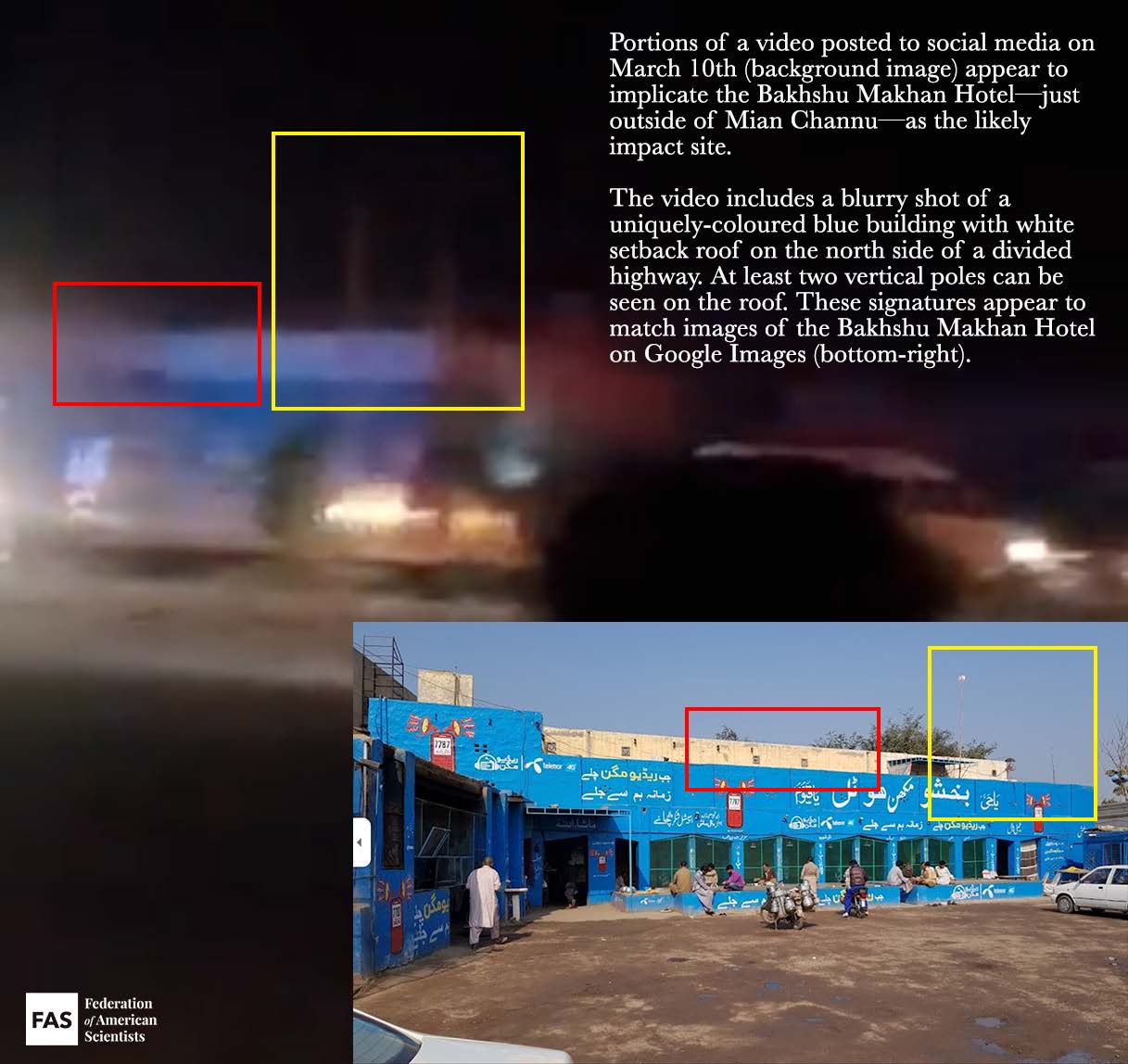
The video’s caption suggests that the object that crashed was an “army aviation aircraft drone;” however, Pakistani military officials subsequently reported that the object was an Indian missile. Neither Pakistan nor India has publicly confirmed what type of missile it was; however, in a March 10th press conference, Pakistani military officials stated that “we can so far deduce that it was a supersonic missile––an unknown missile––and it was launched from the ground, so it was a surface-to-surface missile.”
This statement, in addition to photos of the debris and other official details relating to range, speed, altitude, and flight time of the object, suggest that it was very likely a BrahMos cruise missile.
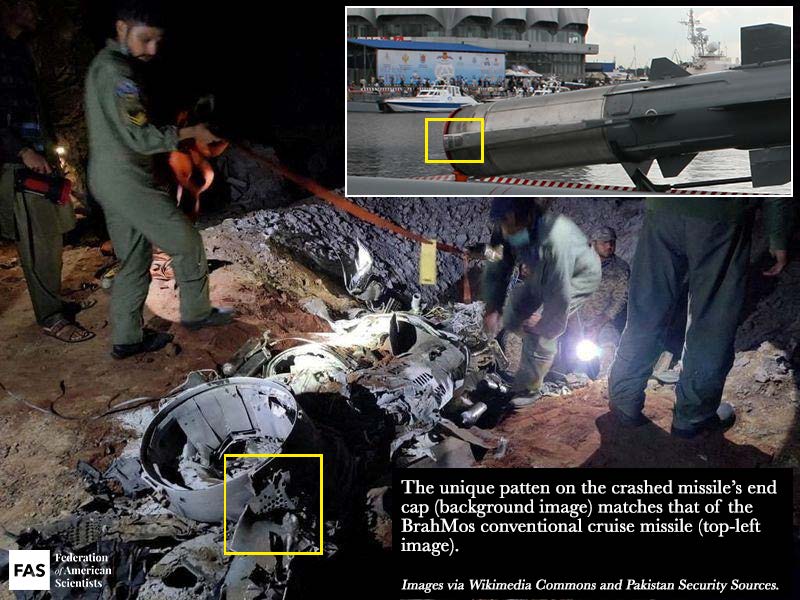
BrahMos is a ramjet-powered, supersonic cruise missile co-developed with Russia, that can be launched from land, sea, and air platforms and can travel at a speed of approximately March 2.8. The US National Air and Space Intelligence Centre (NASIC) suggested that an earlier version of BrahMos had a range of “less than 300” kilometers, but the Indian Ministry of Defence recently announced on 20 January 2022 that it had extended the BrahMos’ range, with defence sources saying that the missile could now travel over 500 kilometres. The reported speed of the “high-speed flying object,” as well as the distance traveled, matches the publicly-known capabilities of the BrahMos cruise missile.
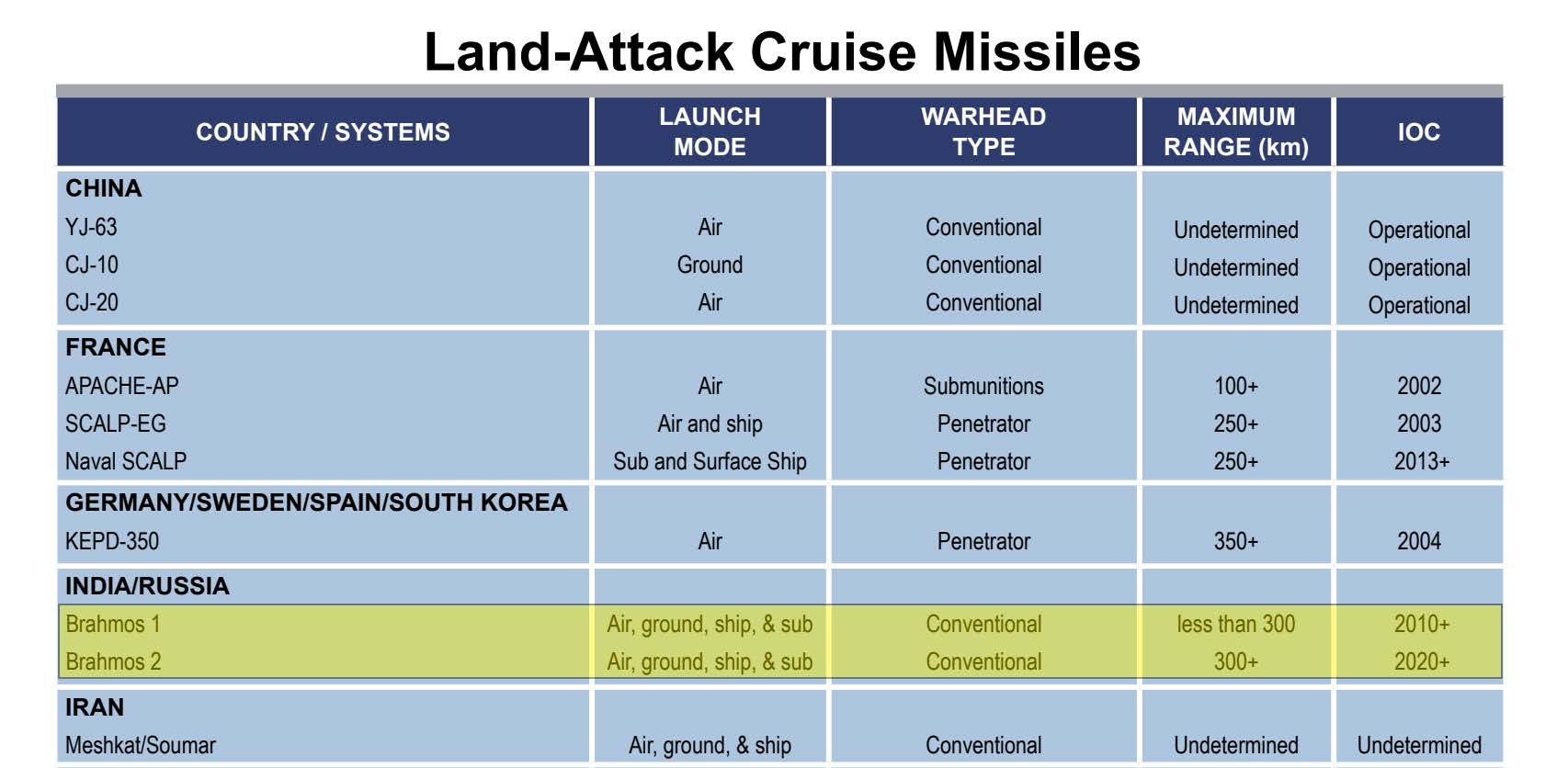
The National Air and Space Intelligence Center’s 2017 Ballistic and Cruise Missile report lists two versions of the BrahMos missile as “conventional.”
Although many Indian media outlets often describe the BrahMos as a nuclear or dual-capable system, NASIC lists it as “conventional,” and there is no public evidence to indicate that the missile can carry nuclear weapons.
India has launched a Court of Inquiry to determine how the incident occurred; however, the Indian government has otherwise remained tight-lipped on details. In the absence of official statements, small snippets have trickled out through Indian and Pakistani media sources––prompting several questions that still need answers.
How did the missile get “accidentally” launched?
According to the Times of India, an audit was being conducted by the Indian Air Force’s Directorate of Air Staff Inspection at the time of the launch. As part of that audit, or possibly as part of a separate exercise, it appears that target coordinates––including mid-flight waypoints––were fed into the missile’s guidance system. According to Indian defence sources, in order to launch the BrahMos, the missile’s mechanical and software safety locks would also have had to be bypassed and the launch codes would have had to be entered into the system.
The BrahMos does not appear to have a self-destruct mechanism. As a result, once the missile was launched, there was no way to abort.
Given that defence sources indicate that the missile “was certainly not meant to be launched,” it still remains unclear whether the launch was due to human or technical error. On March 11th, in its first public statement about the incident, the Indian government stated that “a technical malfunction led to the accidental firing of a missile.” However, since the formal convening of a Court of Inquiry, the government has since changed its rhetoric, with Indian officials stating that “the accidental firing took place because of human error. That’s what has emerged at this stage of the inquiry. There were possible lapses on the part of a Group Captain and a few others.” Tribute India reports that there are currently four individuals under investigation.
While this is certainly a plausible explanation for the incident, it is also worth noting that the Indian government would be financially incentivized to emphasize the human error narrative over a technical malfunction narrative. On January 28th, India concluded a $374.96 million deal with the Philippines to export the BrahMos––a deal which amounts to the country’s largest defence export contract. Additional BrahMos exports will be crucial for India to meet its ambitious defence export targets by 2025, and the negative publicity associated with a possible BrahMos technical malfunction could significantly hinder that goal.
Did Pakistan track the missile correctly?
In a press conference on March 10th, Pakistani military officials noted that Pakistan’s “actions, response, everything…it was perfect. We detected it on time, and we took care of it.” However, Indian military officials have publicly disputed Pakistan’s interpretation of the missile’s flight path. Pakistan announced on March 10th that the missile was picked up near Sirsa; however, Indian officials subsequently stated that the missile was launched from a location near Ambala Air Force Station, nearly 175 kilometers away. India’s explanation is likely to be more accurate, given that there is no known BrahMos base near Sirsa, but there is one near Ambala (h/t @tinfoil_globe). Indian defence sources have also suggested that the map of the missile’s perceived trajectory that the Pakistani military released on March 10th was incorrect.
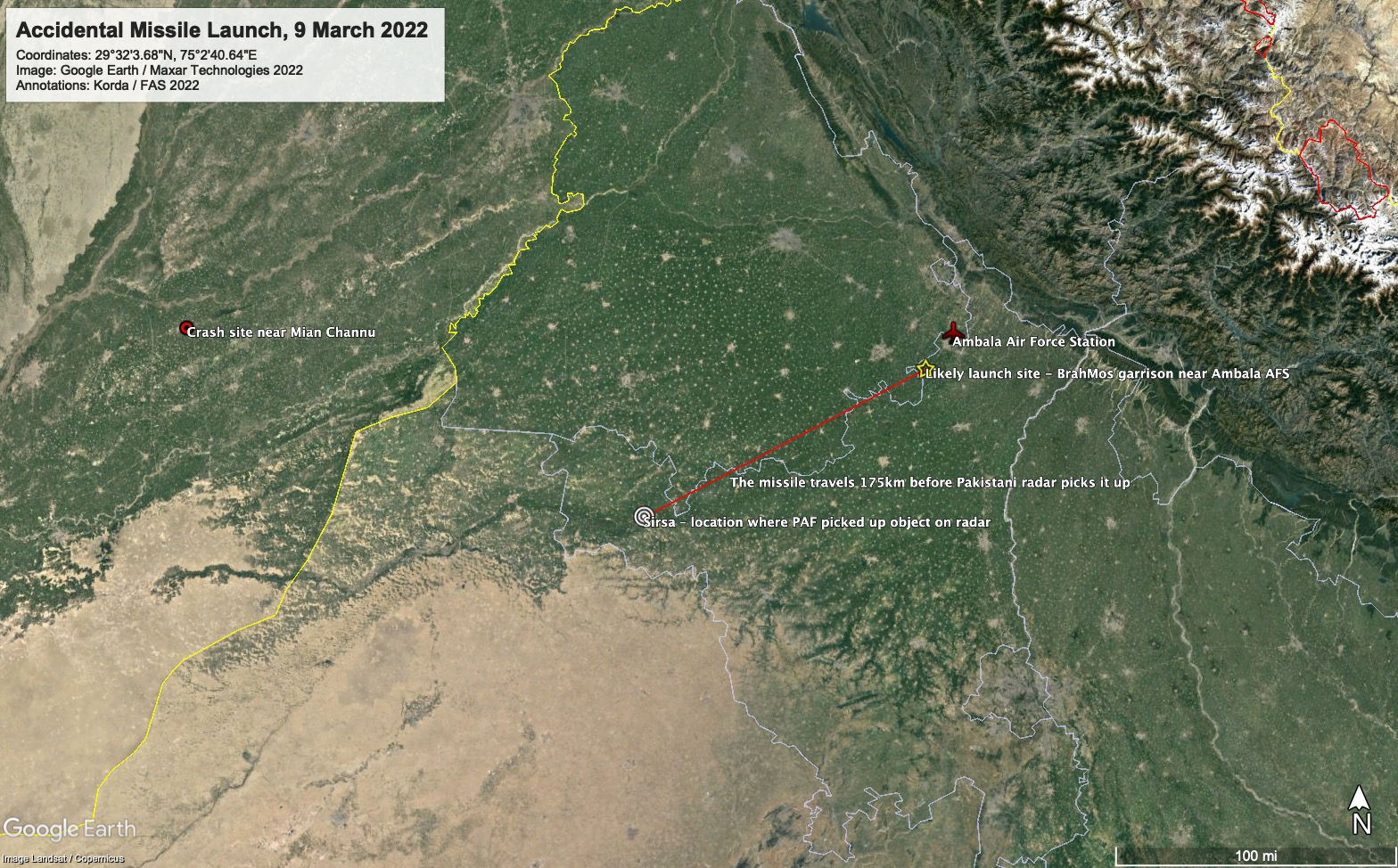
Annotated Google Earth image showing the 175 kilometer distance between the likely launch site and Pakistan’s radar pickup.
Furthermore, Pakistani officials announced on March 10th that the missile’s original destination was likely to be the Mahajan Field Firing Range in Rajasthan, before it suddenly turned and headed northwest into Pakistan. However, Indian defence sources have since suggested that the missile was not actually headed for the Mahajan Field Firing Range, but instead was “follow[ing] the trajectory that it would have in case of a conflict, but ‘certain factors’ played a role in ensuring that any pre-fed target was out of danger.” Given that the impact site was not near any critical military or political infrastructure, this could suggest that the cruise missile had its wartime mid-flight trajectory waypoints pre-loaded into the system, but its actual target had not yet been selected. If this is the case, then this targeting practice would be similar in nature to how some other nuclear-armed states target their missiles at the open ocean during peacetime––precisely in case of incidents like this one. Although the missile still landed on Pakistani territory, the fact that it did not hit any critical targets prevented the crisis from escalating. It is worth noting, however, that this would certainly not be the case if the missile had actually injured or killed anyone.
During the March 10th press conference, Pakistani officials noted that the Pakistan Air Force did not attempt to shoot down the missile because “the measures in place in times of war or in times of escalation are different [from those] in peace time.” However, India’s challenges to Pakistan’s narrative also raise significant questions about whether the Pakistan Air Force was able to accurately track the missile correctly. If not, then this raises the possibility of miscalculation or miscommunication, and crisis stability would be seriously eroded if a similar situation occurred during a time of heightened tensions.
Were any civilian aircraft put in danger?
In its public statements, Pakistan has emphasized that the accidental missile launch could have put civilian flights in danger, as India did not issue a Notice to Airmen (NOTAM) prior to launch. Governments typically issue NOTAMs in conjunction with missile tests, in order to inform civilian aircraft to avoid a particular patch of airspace during the launch window. Given that India did not issue one, a time-lapse video prepared by Flightradar24 showed that there were several civilian flights passing very close to the missile’s flight path at the time of launch. The video erroneously suggests that the missile traveled in a straight line from Ambala to Mian Channu, when it appears to have dog-legged in mid-flight; however, the video is still a useful resource to demonstrate how crowded the skies were at the time of the accident.
A screenshot of a video prepared by Flightradar24, showing that there were several civilian flights passing very close to the missile’s flight path at the time of launch.
Why was India’s response so poor?
Given the seriousness of the incident, India’s delayed response has been particularly striking. Immediately following the accidental launch, India could have alerted Pakistan using its high-level military hotlines; however, Pakistani officials stated that it did not do so. Additionally, India waited two days after the incident before issuing a short public statement.
India’s poor response to this unprecedented incident has serious implications for crisis stability between the two countries. According to DNA India, in the absence of clarification from India, Pakistan Air Force’s Air Defence Operations Centre immediately suspended all military and civilian aircraft for nearly six hours, and reportedly placed frontline bases and strike aircraft on high alert. Defence sources stated that these bases remained on alert until 13:00 PKT on March 14th. Pakistani officials appeared to confirm this, noting that “whatever procedures were to start, whatever tactical actions had to be taken, they were taken.”
We were very, very lucky
Thankfully, this incident took place during a period of relative peacetime between the two nuclear-armed countries. However, in recent years India and Pakistan have openly engaged in conventional warfare in the context of border skirmishes. In one instance, Pakistani military officials even activated the National Command Authority––the mechanism that directs the country’s nuclear arsenal––as a signal to India. At the time, the spokesperson of the Pakistan Armed Forces not-so-subtly told the media, “I hope you know what the NCA means and what it constitutes.”
If this same accidental launch had taken place during the 2019 Balakot crisis, or a similar incident, India’s actions were woefully deficient and could have propelled the crisis into a very dangerous phase.
Furthermore, as we have written previously, in recent years India’s rocket forces have increasingly worked to “canisterize” their missiles by storing them inside sealed, climate-controlled tubes. In this configuration, the warhead can be permanently mated with the missile instead of having to be installed prior to launch, which would significantly reduce the amount of time needed to launch nuclear weapons in a crisis.
This is a new feature of India’s Strategic Forces Command’s increased emphasis on readiness. In recent years, former senior civilian and military officials have reportedly suggested in interviews that “some portion of India’s nuclear force, particularly those weapons and capabilities designed for use against Pakistan, are now kept at a high state of readiness, capable of being operationalized and released within seconds or minutes in a crisis—not hours, as had been assumed.”
This would likely cause Pakistan to increase the readiness of its missiles as well and shorten its launch procedures––steps that could increase crisis instability and potentially raise the likelihood of nuclear use in a regional crisis. As Vipin Narang and Christopher Clary noted in a 2019 article for International Security, this development “enables India to possibly release a full counterforce strike with few indications to Pakistan that it was coming (a necessary precondition for success). If Pakistan believed that India had a ‘comprehensive first strike’ strategy and with no indication of when a strike was coming, crisis instability would be amplified significantly.”
India’s recent missile accident––and the deficient political and military responses from both parties––suggests that regional crisis instability is less stable than previously assumed. To that end, this crisis should provide an opportunity for both India and Pakistan to collaboratively review their communications procedures, in order to ensure that any future accidents prompt diplomatic responses, rather than military ones.
Background Information:
- “Indian Nuclear Forces, 2020,” FAS Nuclear Notebook, Bulletin of the Atomic Scientists, July/August 2020.
- “Pakistan Nuclear Weapons, 2021,” FAS Nuclear Notebook, Bulletin of the Atomic Scientists, Sept/Oct 2021.
- “India’s Nuclear Arsenal Takes A Big Step Forward,” FAS Strategic Security Blog, Dec 2021.
- Status of World Nuclear Forces, Federation of American Scientists
This article was made possible with generous support from the John D. and Catherine T. MacArthur Foundation, the New-Land Foundation, the Prospect Hill Foundation, and the Ploughshares Fund. The statements made and views expressed are solely the responsibility of the author.
*[Note: This type of missile accident has apparently happened before; on 11 September 1986, a Soviet missile flew more than 1,500 off-course and landed in China. Thank you to the excellent Stephen Schwartz for the historical reference.]
Categories: Arms Control, ballistic missiles, Deterrence, Disarmament, India, Nuclear Weapons, Pakistan
India’s Nuclear Arsenal Takes A Big Step Forward
On 18 December 2021, India tested its new Agni-P medium-range ballistic missile from its Integrated Test Range on Abdul Kalam Island. This was the second test of the missile, the first test having been conducted in June 2021.
Our friends at Planet Labs PBC managed to capture an image of the Agni-P launcher sitting on the launch pad the day before the test took place.
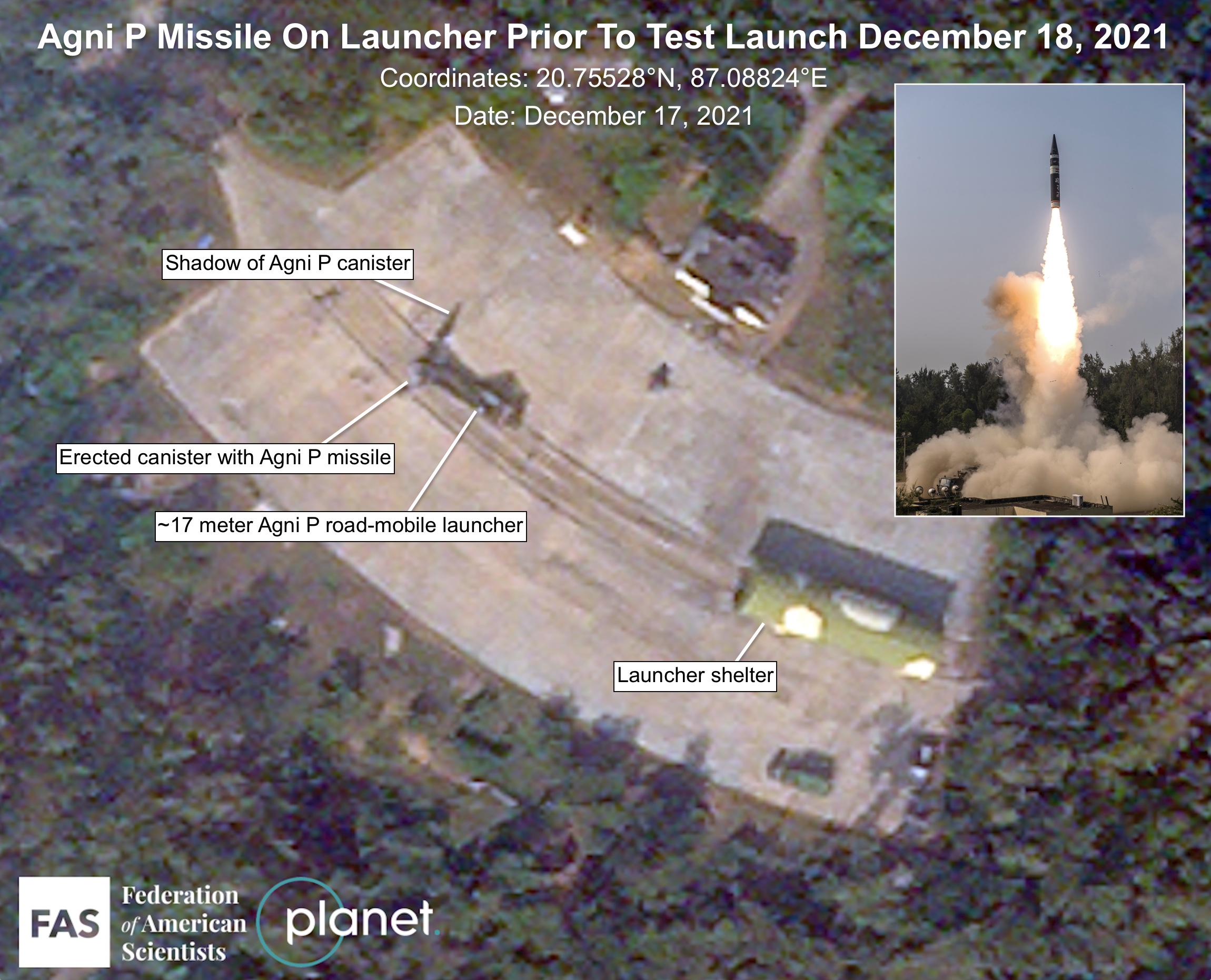
Following both launches of the Agni-P, the Indian Government referred to the missile as a “new generation” nuclear-capable ballistic missile. Back in 2016, when the Defence Research and Development Organisation (DRDO) first announced the development of the Agni-P (which was called the Agni-1P at the time), a senior DRDO official explained why this missile was so special:
“As our ballistic missiles grew in range, our technology grew in sophistication. Now the early, short-range missiles, which incorporate older technologies, will be replaced by missiles with more advanced technologies. Call it backward integration of technology.”
The Agni-P is India’s first shorter-range missile to incorporate technologies now found in the newer Agni-IV and -V ballistic missiles, including more advanced rocket motors, propellants, avionics, and navigation systems.
Most notably, the Agni-P also incorporates a new feature seen on India’s new Agni-V intermediate-range ballistic missiles that has the potential to impact strategic stability: canisterization. And the launcher used in the Agni-P launch appears to have increased mobility. There are also unconfirmed rumors that the Agni-P and Agni-V might have the capability to launch multiple warheads.
Canisterization
“Canisterizing” refers to storing missiles inside a sealed, climate-controlled tube to protect them from the outside elements during transportation. In this configuration, the warhead can be permanently mated with the missile instead of having to be installed prior to launch, which would significantly reduce the amount of time needed to launch nuclear weapons in a crisis. This is a new feature of India’s Strategic Forces Command’s increased emphasis on readiness. In recent years, former senior civilian and military officials have reportedly suggested in interviews that “some portion of India’s nuclear force, particularly those weapons and capabilities designed for use against Pakistan, are now kept at a high state of readiness, capable of being operationalized and released within seconds or minutes in a crisis—not hours, as had been assumed.”
If Indian warheads are increasingly mated to their delivery systems, then it would be harder for an adversary to detect when a crisis is about to rise to the nuclear threshold. With separated warheads and delivery systems, the signals involved with mating the two would be more visible in a crisis, and the process itself would take longer. But widespread canisterization with fully armed missiles would shorten warning time. This would likely cause Pakistan to increase the readiness of its missiles as well and shorten its launch procedures––steps that could increase crisis instability and potentially raise the likelihood of nuclear use in a regional crisis. As Vipin Narang and Christopher Clary noted in a 2019 article for International Security, this development “enables India to possibly release a full counterforce strike with few indications to Pakistan that it was coming (a necessary precondition for success). If Pakistan believed that India had a ‘comprehensive first strike’ strategy and with no indication of when a strike was coming, crisis instability would be amplified significantly.”
For years, it was evident that India’s new Agni-V intermediate-range missile (the Indian Ministry of Defense says Agni-V has a range of up to 5,000 kilometers; the US military says the range is over 5,000 kilometers but not ICBM range) would be canisterized; however, the introduction of the shorter-range, canisterized Agni-P suggests that India ultimately intends to incorporate canisterization technology across its suite of land-based nuclear delivery systems, encompassing both shorter- and longer-range missiles. While Agni-V is a new addition to India’s arsenal, Arni-P might be intended––once it becomes operational––to replace India’s older Agni-I and Agni-II systems.
MIRV technology
It appears that India is also developing technology to potentially deploy multiple warheads on each missile. There is still uncertainty about how advanced this technology is and whether it would enable independent targeting of each warhead (using multiple independently-targetable reentry vehicles, or MIRVs) or simply multiple payloads against the same target.
The Agni-P test in June 2021 was rumored to have used two maneuverable decoys to simulate a MIRVed payload, with unnamed Indian defense sources suggesting that a functional MIRV capability will take another two years to develop and flight-test. The Indian MOD press release did not mention payloads. It is unclear whether the December 2021 test utilized decoys in a similar manner.
In 2013, the director-general of DRDO noted in an interview that “Our design activity on the development and production of MIRV is at an advanced stage today. We are designing the MIRVs, we are integrating [them] with Agni IV and Agni V missiles.” In October 2021, the Indian Strategic Forces Command conducted its first user trial of the Agni-V in full operational configuration, which was rumored to have tested MIRV technology. The MOD press release did not mention MIRVs.
If India succeeds in developing an operational MIRV capability for its ballistic missiles, it would be able to strike more targets with fewer missiles, thus potentially exacerbating crisis instability with Pakistan. If either country believed that India could potentially conduct a decapitating or significant first strike against Pakistan, a serious crisis could potentially go nuclear with little advance warning. Indian missiles with MIRVs would become more important targets for an adversary to destroy before they could be launched to reduce the damage India could inflict. Additionally, India’s MIRVs might prompt Indian decision-makers to try and preemptively disarm Pakistan in a crisis.
India’s other nuclear adversary, China, has already developed MIRV capability for some of its long-range missiles and is significantly increasing its nuclear arsenal, which might be a factor in India’s pursuit of MIRV technology. A MIRV race between the two countries would have significant implications for nuclear force levels and regional stability. For India, MIRV capability would allow it to more rapidly increase its nuclear stockpile in the future, if it so decided––especially if its plutonium production capability can make use of the unsafeguarded breeder reactors that are currently under construction.
Implications for India’s nuclear policy
India has long adhered to a nuclear no-first-use (NFU) policy and in 2020 India officially stated that there has been no change in its NFU policy. Moreover, the Agni-V test launch in October 2021 was accompanied by a reaffirmation of a “’credible minimum deterrence’ that underpins the commitment to ‘No First Use’.”
At the same time, however, the pledge to NFU has been caveated, watered-down, and called into question by government statements and recent scholarship. The increased readiness and pursuit of MIRV capability for India’s strategic forces could further complicate India’s adherence to its NFU policy and could potentially cause India’s nuclear adversaries to doubt its NFU policy altogether.
Given that Indian security forces have repeatedly clashed with both Pakistani and Chinese troops during recent border disputes, potentially destabilizing developments in India’s nuclear arsenal should concern all those who want to keep regional tensions below boiling point.
Background Information:
- “Indian Nuclear Forces, 2020,” FAS Nuclear Notebook, Bulletin of the Atomic Scientists, July/August 2020.
- Status of World Nuclear Forces, Federation of American Scientists
This article was made possible by generous support from the John D. and Catherine T. MacArthur Foundation, the New Land Foundation, the Prospect Hill Foundation, and the Ploughshares Fund. The statements made and views expressed are solely the responsibility of the authors.
NNSA Removes F/A-18F Super Hornet From Nuclear Bomb Fact Sheet
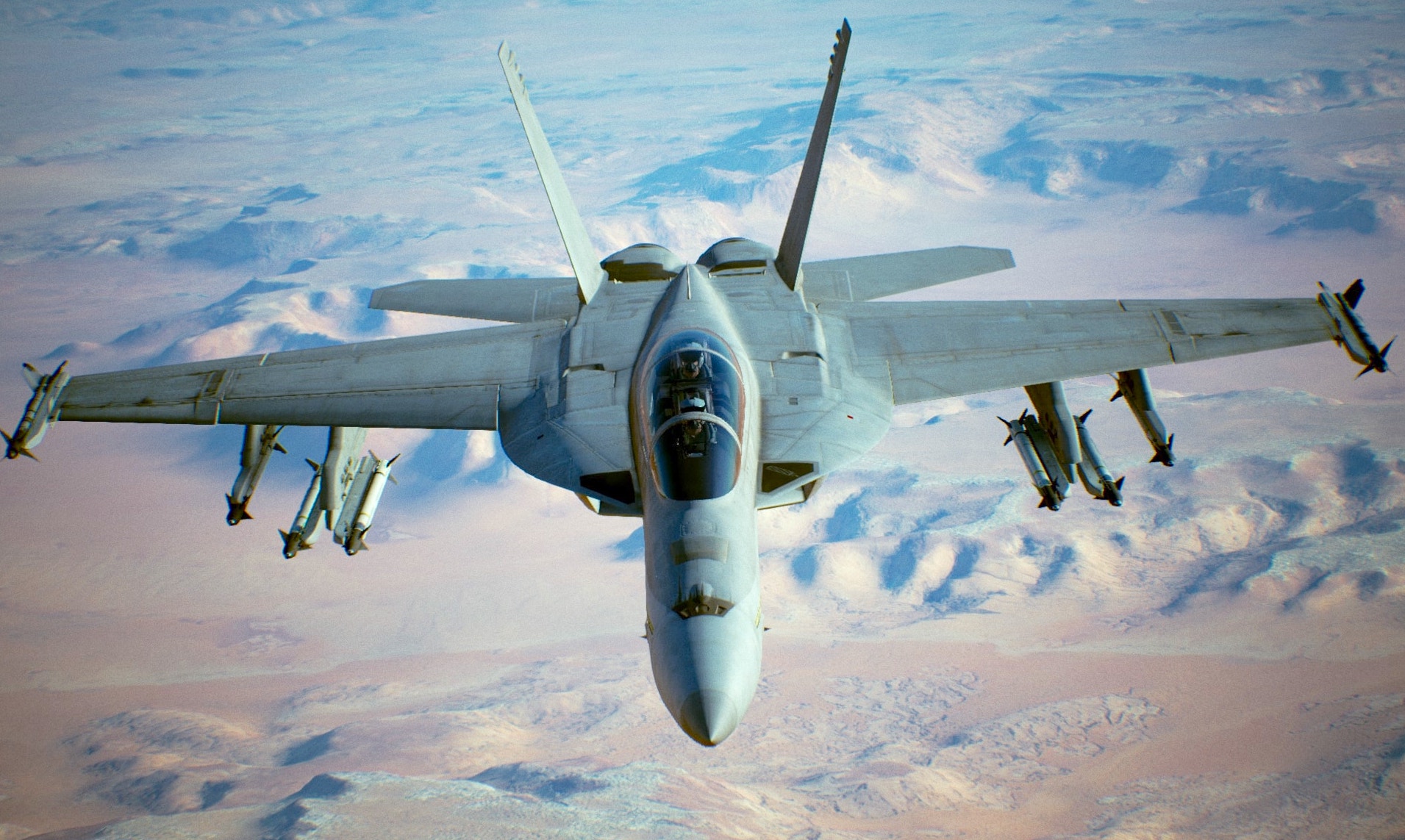
The F/A-18F is a two-seat version of the F/A-18E. Image: US Department of Defense
The National Nuclear Security Administration (NNSA) has quietly removed the F/A-18F Super Hornet from its B61-12 nuclear bomb fact sheet.
No public explanation has been offered for why the aircraft was removed or added in the first place.
The F/A-18F was added to a “November 2021” fact sheet published in early December, which listed the aircraft as one of three future aircraft platforms for the new B61-12 guided nuclear bomb (see image below). An earlier version from 2018 did not mention the F/A-18F.
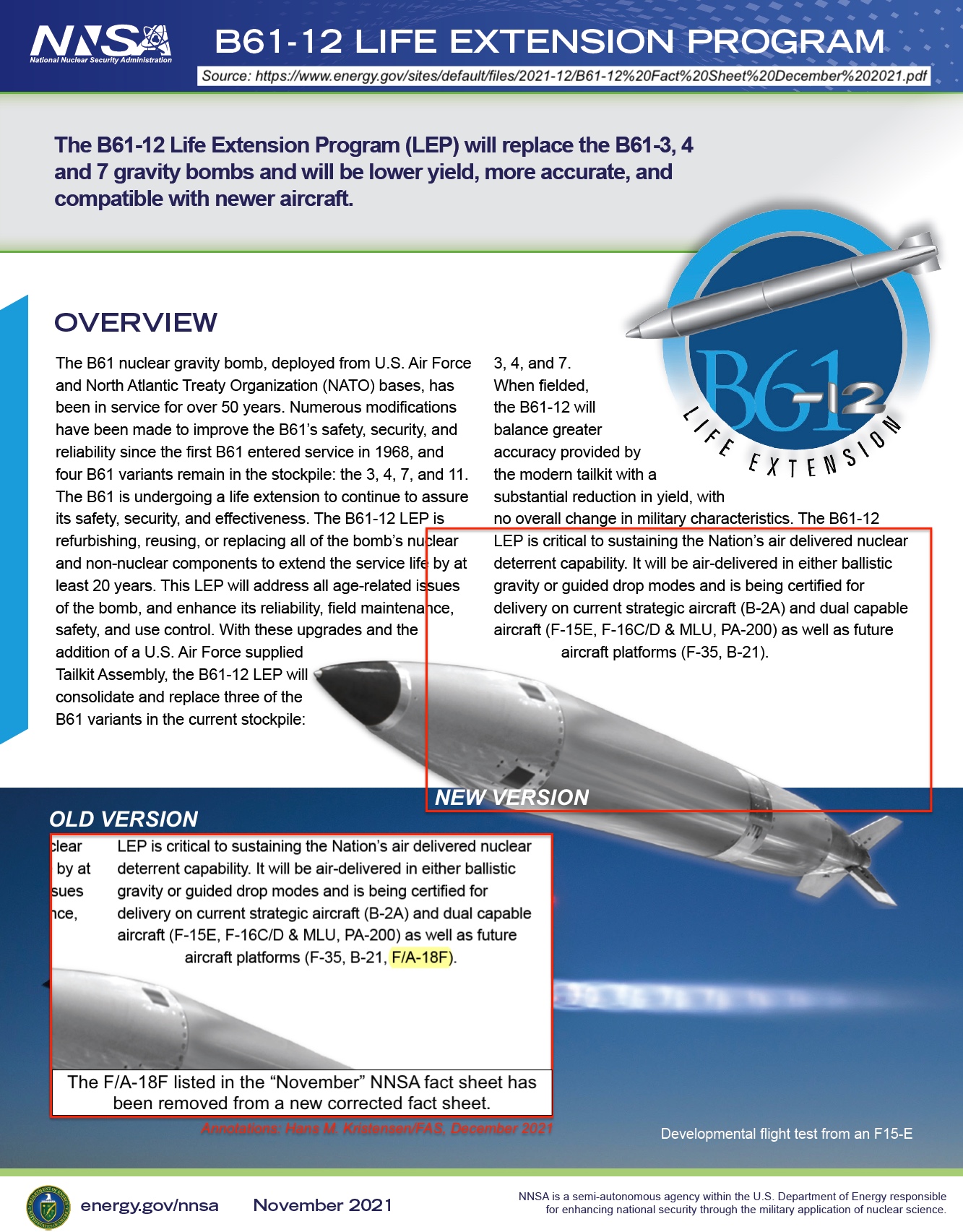
NNSA in 2021 added, and then deleted, the F/A-18F Super Hornet from its B61-12 nuclear bomb fact sheet.
The reason for including the F/A-18F was not stated. It could potentially indicate anticipated sale to Germany to replace its aging Tornado aircraft in the “nuclear sharing” strike mission, or that the U.S. Navy was planning to reintroduce nuclear capability on aircraft carriers (unlikely).
In response to questions from me, NNSA initially said neither of those were the reason for including the F/A-18F in the fact sheet. But after coordinating with the Defense Department, NNSA asked me to ignore that explanation saying the listing of the F/A-18 in the fact sheet was a mistake.
I have also asked the Defense Department, but it has not responded yet. Update: DOD said “there is not a requirement for the F/A-18F to be certified to carry the B61-12.”
What’s Going On?
The 2018 Nuclear Posture Review (NPR) considered many new nuclear weapons, but only two made it into the public version of the document as “nuclear supplements”: the low-yield W76-2 Trident warhead and the nuclear sea-launched cruise missile (SLCM-N). The W76-2 is already deployed, and the Biden administration’s NPR is currently considering whether to continue the SLCM-N. Doing so would violate the 1992 Presidential Nuclear Initiative.
One of the ideas proposed was reintroducing nuclear weapons on the aircraft carriers, an idea pushed by some former officials. The military rejected the idea. The carriers were denuclearized by the 1994 Nuclear Posture Review, the Navy does not want nukes back on them, but it would in any case probably have been the F-35C – not the F/A-18F.
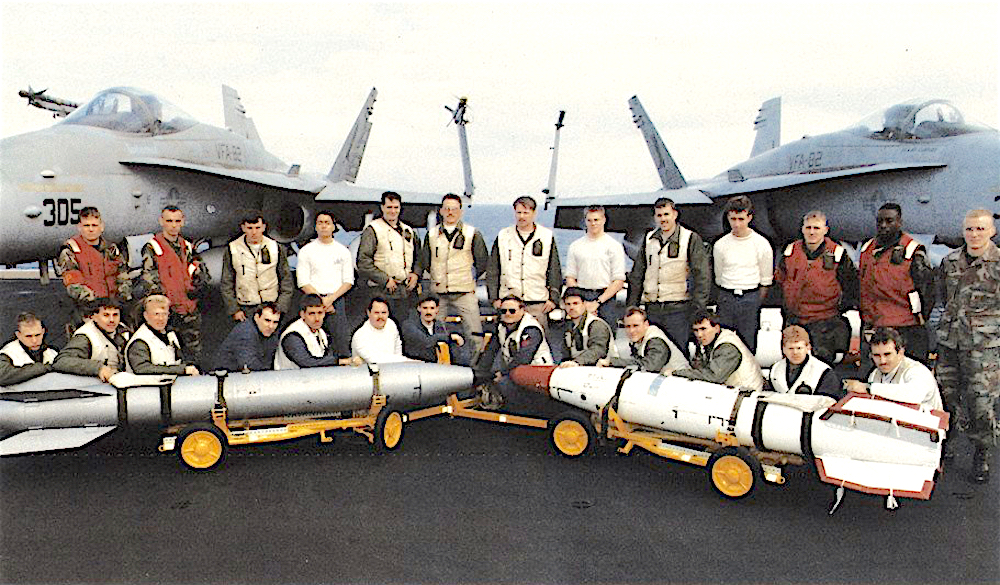
F/A-18 aircraft (background) used to be tasked with delivering nuclear bombs from aircraft carriers. The image shows B61 (left) and B43 nuclear bomb trainers on the deck of USS America (CV-66) during the 1991 Gulf War. Image: US Navy.
Instead, the appearance of the F/A-18F in the NNSA fact sheet probably reflected preparations to support Germany’s anticipated purchase the aircraft for its nuclear mission, and that the fact sheet was likely corrected because the German government has not publicly announced its selection of the F/A-18 (and the Parliament has not yet agreed to pay for it).
There is a lot of opposition in Germany to nuclear weapons and the question of whether to continue participation in the nuclear-sharing mission is politically sensitive. In 2020, Der Spiegel reported that the German defense minister had informed the Pentagon that Germany intended to buy the F/A-18 to replace the current Tornados (PA-200) in the “nuclear-sharing” strike mission. The report caused an uproar because the Parliament had not been informed or agreed. The minister later denied that a decision had been made, at least officially.
Pressure has been building on Germany to continue the nuclear-sharing mission. During the negotiations of the new coalition government, NATO secretary general Johan Stoltenberg issued what appeared to be an empty threat that “the alternative is that we easily end up with nuclear weapons in other countries in Europe, also to the east of Germany.”
The threat appeared empty because NATO had just endorsed a new defense plan to protect against “the growing threat from Russia’s missile systems” that included “improving the readiness” of NATO nuclear forces. Why NATO would choose to deploy its nuclear forces further east closer to those missiles is unclear. Moreover, deployment of nuclear weapons further east would require NATO consensus, which seems unlikely. But the threat was heard in Moscow and Stoltenberg later had to walk back his threat by reassuring that “We have no plans of stationing any nuclear weapons in other countries than [those that] already have these nuclear weapons….”
The tactical nuclear weapons mission in Europe was recently exercised in the Steadfast Noon exercise held in northern Italy in October. The exercise included German Tornado fighter-bombers. There are an estimated 100 US non-strategic B61 nuclear bombs deployed in Europe, including about 15 at Buchel Air Base in Germany (see map below).
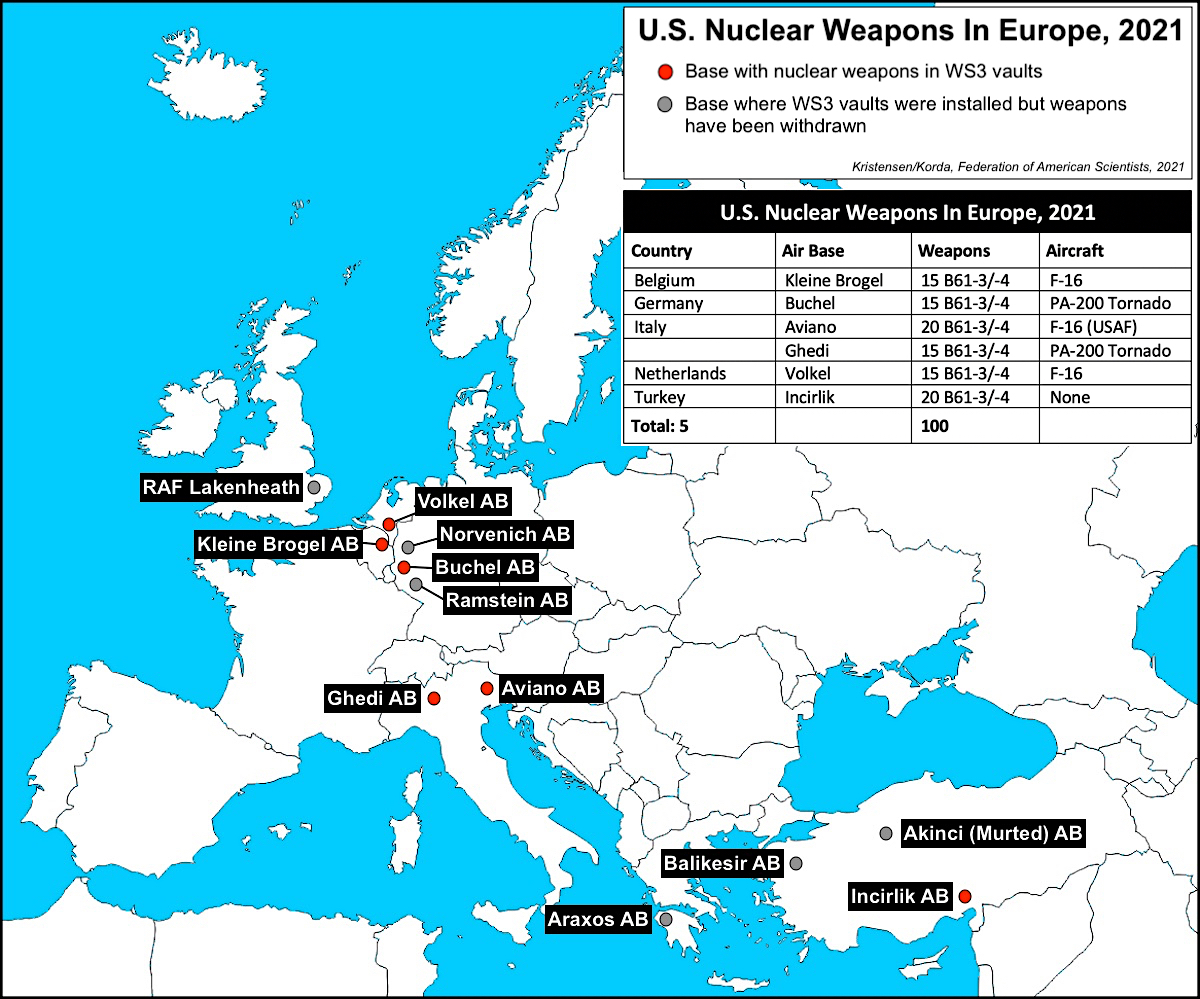
The US Air Force deploys an estimated 100 B61 nuclear bombs at five bases in six European NATO countries. There are no nuclear weapon storage facilities in the new Eastern European NATO countries.
The pressure apparently worked: The new German coalition government took office with a program that agreed to continue Germany’s participation in the nuclear-sharing mission. Although the US Navy has decided to end production of the F/A-18E/F after this year to focus resources on the F-35C, Boeing could continue production for foreign customers, including Germany. And Boeing officials reportedly expect Germany to issue a letter of request for the F/A-18F Super Hornet and EA-18G Growler in early 2022.
The F/A-18F has been removed from the fact sheet for now, but if Germany submits a formal request to buy the aircraft, NNSA will have to update the fact sheet once again.
Additional information:
- NNSA B61-12 Fact Sheet
- Video Shows Earth-Penetrating Capability of B61-12 Nuclear Bomb
- FAS Nuclear Notebook: United States nuclear weapons, 2021
- FAS overview: Status of World Nuclear Forces
This publication was made possible by generous support from the John D. and Catherine T. MacArthur Foundation, the New Land Foundation, the Ploughshares Fund, and the Prospect Hill Foundation. The statements made and views expressed are solely the responsibility of the author.
Reforming Nuclear Research Practices in the Marshall Islands
Summary
In the mid-20th century, the United States test-detonated dozens of nuclear weapons in the Republic of the Marshall Islands (RMI). Using the RMI as a test site for nuclear- weapons research allowed the U.S. to better understand the effects of such weapons and their destructive capacities — but at significant cost. Conducting nuclear tests in the vulnerable RMI harmed human health, fomented distrust in research sponsored by the U.S. government, and fueled tensions with the Marshallese. Fallout from the tests undermined U.S. influence in the Pacific, cooperation over ecological restoration, and the reputation of the U.S. research enterprise. Building back relations with the RMI (and other allies that have long supported the United States) is crucial for enabling the Biden Administration to undo the adverse effects of Trump-era policies on international relations and the environment, especially amid rising threats from China and Russia.
To that end, the Department of Energy (DOE) and Department of Interior (DOI) should adopt provisions for conducting nuclear research with and in the Marshall Islands that will: (i) increase transparency and trust in American research concerning the Marshall Islands, and (ii) elevate Marshallese voices in the fight for preservation of their lands. These provisions are as follows:
- All collected data should be translated into Marshallese and shared with RMI officials and relevant stakeholders.
- When appropriate (e.g., when security and privacy considerations permit), collected data should be published in an easy-to-access online format for public consumption.
- All research should be clearly laid out and submitted to the RMI National Nuclear Commission (NNC) in accordance with the NNC’s Nuclear Research Protocol.
- The United States should coordinate with the NNC, the College of the Marshall Islands (CMI) Nuclear Institute, regional agencies, and other relevant nongovernmental organizations and local stakeholders to ensure that local knowledge is considered in the design of nuclear-related research and data projects.
- All possible steps should be taken to include the participation of Marshallese residents in research ventures and operations.
A Closer Look at China’s Missile Silo Construction

What’s underneath the shelters over China’s suspected silo construction sites? Image © 2021 Maxar Technologies
After the discovery during the summer of what appears to be at least three vast missile silo fields under construction near Yumen, Hami, and Ordos in north-central China, new commercial satellite images show significant progress at the three sites as well as at the People’s Liberation Army Rocket Force (PLARF)’s training site near Jilantai.
The images provide a vivid and rare public look into what is otherwise a top-secret and highly sensitive construction program. The Chinese government has still not officially confirmed or denied that the facilities under construction are silos intended for missiles and there are many uncertainties and unknowns about the nature and role of the facilities. In this article we use words like suspected, apparent, and probable to remind the reader of that fact.
Yet our analysis of hundreds of satellite images over the past three years of the suspected missile silo fields and the different facilities that are under construction at each of them have increased our confidence that they are indeed related to the PLARF’s modernization program. In recent analysis of new satellite images obtained from Planet Labs and Maxar Technologies, we have observed almost weekly progress in construction of suspected silos as well as discovered unique facilities that appear intended to support missile operations once the silo fields become operational.
In this article we describe the progress we have observed. We first describe the shelters, then what we see under the shelters, unique support facilities, and end with overall observations.
Shelter Features and Activities
Some of the most visible features at each of China’s newly-discovered probable missile silo fields are the environmental shelters that cover each suspected silo headworks. It was these structures, first seen at Jilantai, that led to the discovery of the three large suspected missile silo fields. Shelters are not new phenomena in Chinese missile construction; declassified reports from the US National Photographic Interpretation Center suggest that in the 1970s and 1980s China used a mixture of “large rectangular covers,” “camouflage nets,” and other types of shelters to protect its silos from the elements, as well as from spy satellites above.
The construction progression typically goes like this: a space for each silo headworks is cleared, then the shelter is erected before large-scale excavation begins. Occasionally the silo hole – or part of it – is excavated first and the shelter is erected over it before the silo components are installed. Several satellite images show semi-circle structural forms that may be lowered into the hole and assembled to form the silo walls during this phase. Several months later, the shelter is removed, and construction continues in the open-air with less sensitive auxiliary structures.
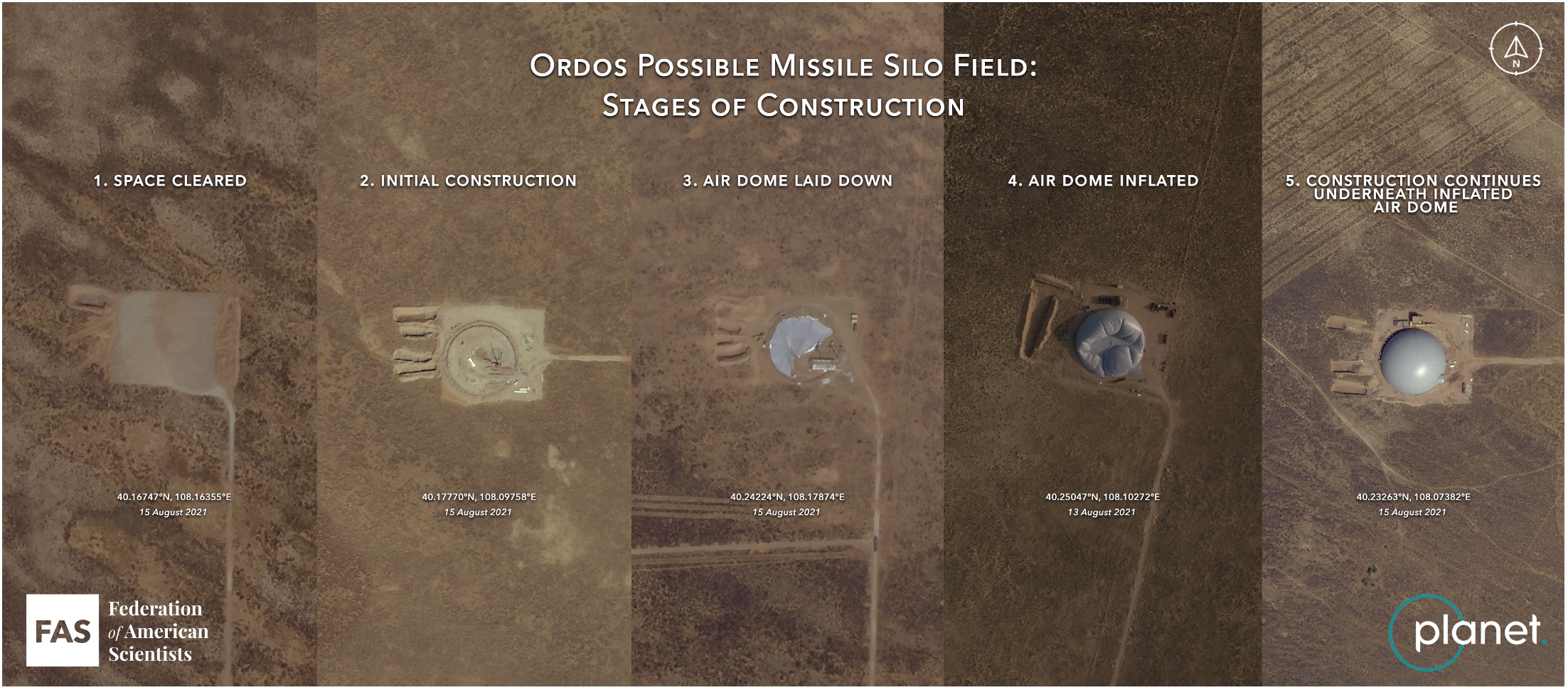
Suspected missile silos near Ordos at different stages of construction. Images © 2021 Planet Labs.
Apart from hiding silo details from satellites, these environmental shelters play an important role in the construction process: winter temperatures in areas like the Jilantai training area can reach below -25 degrees Celsius and pouring concrete in cold temperatures can cause it to freeze and crack. Additionally, many of China’s suspected silo sites are located in desert areas with periodic sandstorms. Spring floods are another challenge, so many silo sites and roads are elevated above the ground level and often with barriers or tunnels to prevent water damage. Environmental shelters, therefore, help keep construction running smoothly and on schedule year round, and they can be erected and dismantled in just a couple of days.
Interestingly, China appears to be experimenting with several different types of shelters for each of its suspected silo fields. The reason for this may have to do with practical construction issues rather than what is being constructed under them.
- Short Rectangular Shelters
The most common shelter visible at China’s suspected silo complexes is a rectangular dome-like structure very similar to those used at indoor tennis courts or soccer pitches. Each structure appears to be air-inflated with an estimated area of 4,125 square meters, and must be accessed through a series of airlocks––one for pedestrians and an extended one for vehicles. The external ventilation system provides climate control and a slight continuous overpressure inside the dome, allowing it to retain its rounded shape. See example of inflatable shelter.
Identical rectangular air domes are visible at the Jilantai missile training area, the suspected Yumen silo site, and the suspected Hami silo site. While this does not necessarily prove that identical construction is taking place underneath each dome, it does imply a connection of the activities at the three sites.
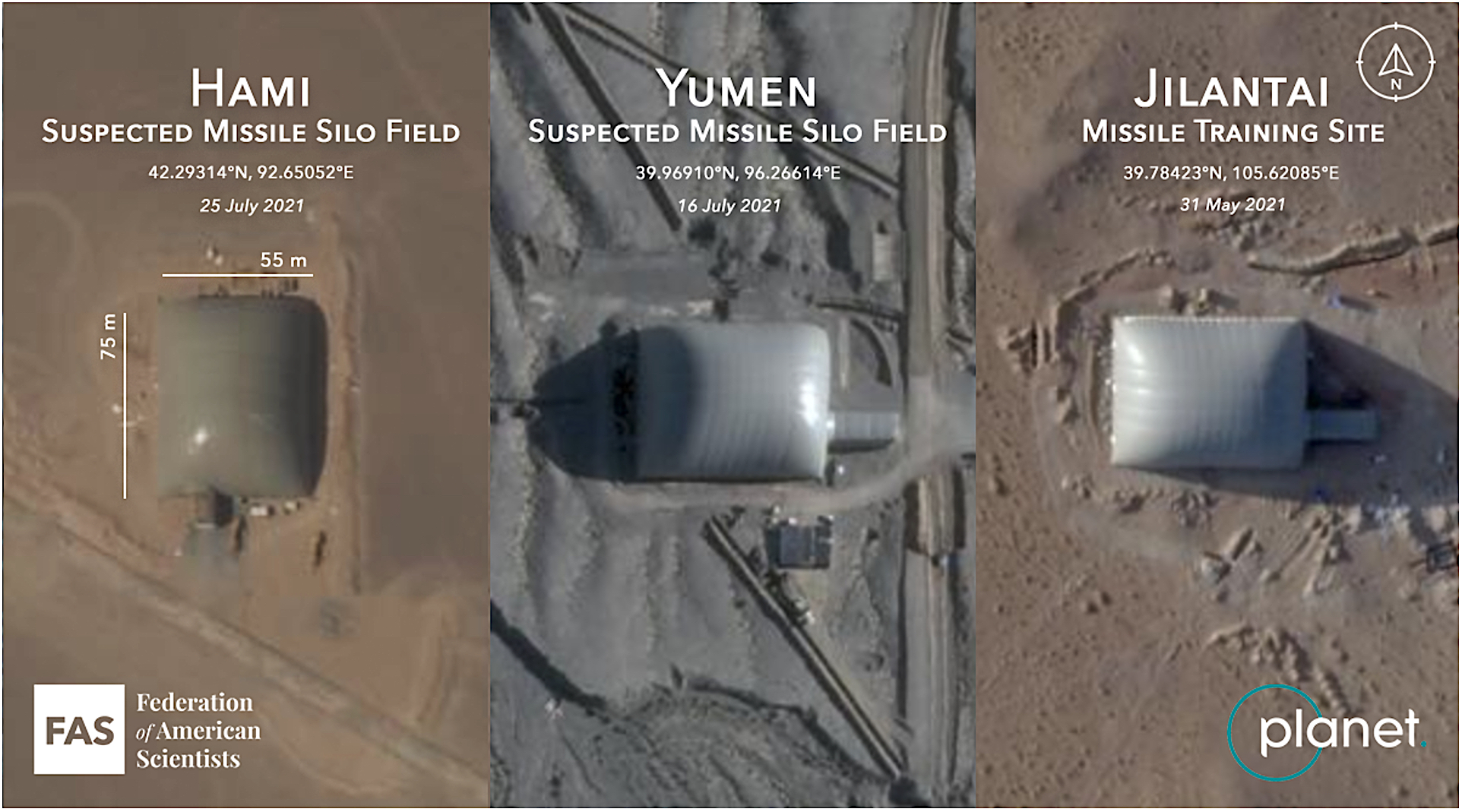
Identical shelter domes seen at Hami, Yumen, and Jilantai. Images © Planet Labs.
In July 2021, Capella Space––a satellite company specializing in synthetic aperture radar––imaged one of the domes at the Yumen site. The SAR image allowed analysts to see the outlines of some structures underneath the dome, although it is difficult to discern much from the image except the clearly-visible framework of the external airlock. There appears to be significant activity directly in the center of the dome, which is where the suspected silo hole appears to be located.
- Long Rectangular Shelters
At the suspected Hami silo field, we see deployment of a slightly longer variant of the regular dome shelter. The Hami site is at a later stage of development than its counterpart at Yumen. The structures measure approximately 20 meters longer than the aforementioned domes erected at Yumen and Jilantai, but otherwise appear to be very similar. One discernible difference between the two is that the vehicle airlock is not extended outside of the dome’s main structure but appears to be embedded within the dome itself.
Although the suspected silo site at Hami contains both types of inflatable domes, there are now more of the longer variant than the shorter version. Given that Hami is a newer site than both Yumen and Jilantai, it is possible that construction has now switched entirely to the longer version and will continue to use this structure for future sites. While Yumen does not appear to have any longer domes on-site, it is notable that some crude extensions to its shorter domes were erected there. This adds approximately 20 meters and expands the short dome to the size of the new longer dome (see image below).
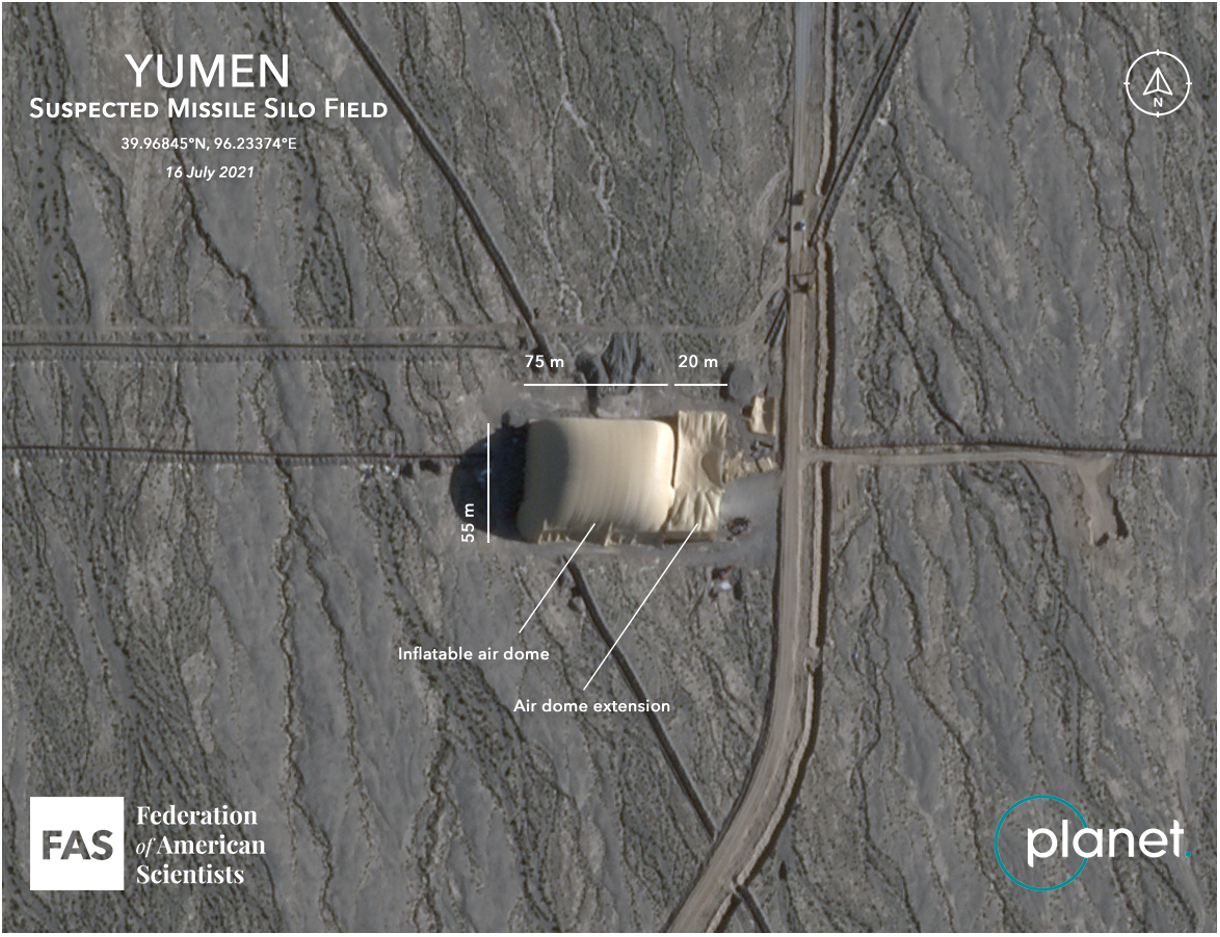
Some short dome shelters were extended. Image: © 2021 Planet Labs.
This reason for building longer dome shelters could indicate that silo excavation and construction activities required more space than the PLARF originally thought, and that they are now having to adjust for their newer sites. The estimated area of the longer domes is 4,925 square meters, excluding the approximately 300 square meters needed for the embedded vehicle airlock; this makes the total area slightly less than that of an NFL football field, which has an area of approximately 5,350 square meters.
- Round Shelters
At a third suspected missile silo field near Ordos is deploying a different type of inflatable air dome. Instead of the shorter and longer rectangular domes, the PLARF has opted to use round domes with circular bases. Interestingly, these circular domes appear to have several different types of patterns (see image below).

Round dome shelters at the suspected missile silo field near Ordos have more room but appear to serve the same purpose. Images © 2021 Planet Labs.
Other than the differences in shape and pattern, the domes appear to function the same way as the other sites. Similar to the longer rectangular air domes, the vehicle airlock appears to be embedded within the dome itself.
There are some potential advantages to these circular domes, compared to the rectangular domes used at Yumen, Hami, and Jilantai. A rounder shape is stronger than a rectangular one, and offers the maximum amount of internal space with the least amount of surface area. This means that less fabric is needed to create the structure, thus creating a potential cost savings. The estimated area of the round domes is approximately 4,725 square meters, excluding the 300 square meters needed for the embedded vehicle airlock.
- Solid Shelters
The PLARF has also constructed solid, rectangular structures to temporarily cover some of its suspected missile silo sites. In 2018, Catherine Dill noted that a solid 32m x 66m gable-roofed structure had covered a silo at Wuzhai before it was removed in December 2017. In 2019, Hans Kristensen’s discovery of the Jilantai missile training area included a solid structure with similar measurements covering a newly-constructed silo; in total, the first four apparent silos at Jilantai were built under solid shelters. In 2020, Scott LaFoy and Decker Eveleth also noted the presence of four high-bay structures with similar measurements covering previously-identified DF-4 ICBM launch sites at Sundian.
In addition to these sites, 11 identical solid structures have been erected at the suspected Yumen missile silo site (see image below). These structures––which were among the very first structures erected at Yumen between March and October 2020––are outliers for the entire complex, which is subsequently has filled entirely with shorter dome shelters that were deployed later in the complex’s construction period (see image below).
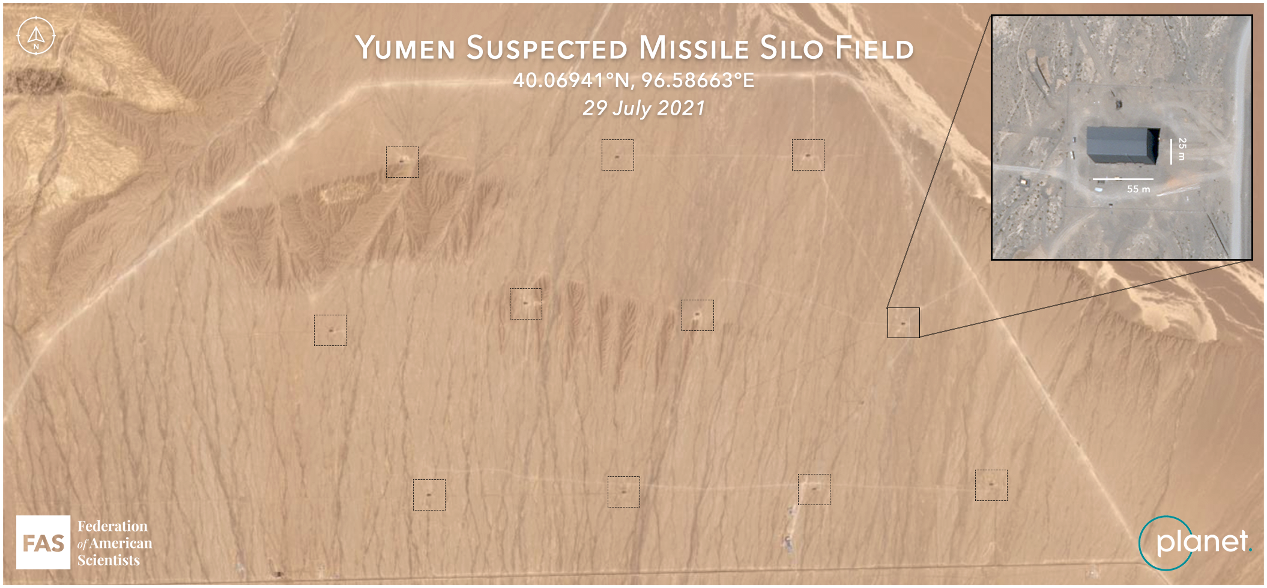
The first 11 shelters erected at Yumen were solid, like the first four at Jilantai. Click on image to full size. Image © 2021 Planet Labs.
What Is Underneath The Shelters?
Several shelters over suspected silo construction sites have now been removed, which allows us to better determine the possible function of the sites. The new satellite images show features that reaffirm that the sites appear to be silos in various stages of construction. A few satellite images taken at sites before the shelters were built already showed features strongly suggesting the sites were missile silos, and the first four sites at Jilantai are clearly silos. But with the growing number of shelters being removed, so far over 40, the evidence pointing to silo construction is in our assessment getting stronger.
Because silo construction at the PLARF training site near Jilantai began before construction at the three large missile silo fields, developments at Jilantai are likely precursors for events that will appear later at the other sites. One of the first four silos (39.76470°N, 105.53952°E) appears to show silo operations. Preparation of this site began in July 2019, and by early-August, satellite images showed excavation of a six-meter-wide deep hole inside a shallower 14–15-meter hole. The following month a shelter was built over the silo apparently to hide technical details from satellites. This was a solid shelter similar to the first 11 later constructed at Yumen. Once silo construction had been completed the shelter was dismantled while construction of access roads and command and control facilities continued. This summer, a Maxar satellite photo showed what appeared to be a missile loading operation at the site, and on October 29, a Planet Labs satellite photographed additional crane operations over the open silo. The silo is probably not yet operational.
The first four silos at Jilantai were covered by garage-like shelters. But in early 2021, dome-like shelters were erected over an additional 10 possible missile silos. These domes, or inflatable shelters, are identical or similar to the shelters over the vast majority of suspected silo sites at Hami, Yumi, and Ordos. In late-October, the dome shelters at Jilantai began to come down. A satellite image of one of these (39.72593°N, 105.52898°E) shows clear signs of a possible silo, first during the early stages immediately before the shelter was erected, and finally immediately after shelter was dismantled. Visible features include what appear to be a silo hatch, small auxiliary buildings, and ground markings from possible buried command and control cables or power lines. The other sites at Jilantai have the same features and dimensions.
The silo features are also clearly visible at Yumen, which began construction earlier than Hami and Ordos. So far, the shelters have been removed from at least 29 suspected silos at Yumen. The structures are very similar: an apparent silo hatch on an elevated dirt mound, with small auxiliary structures, a wide-turn access road presumably for use by missile transport and maintenance trucks. One of the apparent silo sites under construction at Yumen is shown below. Over the next several months, the remaining surface features will be completed.
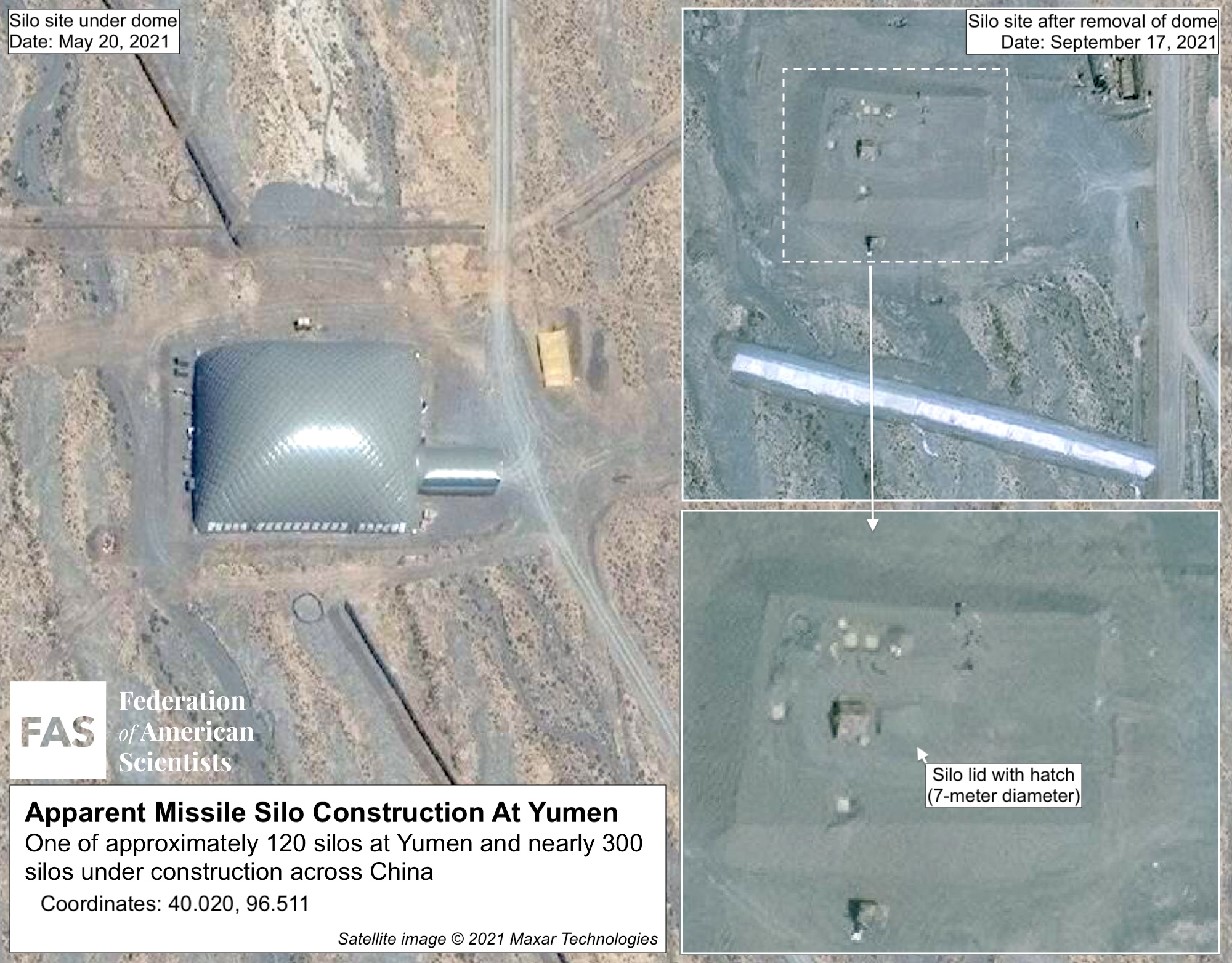
Suspected silos under construction at Yumen show features very similar to those observed at Jilantai. Click on image to view full size. Images © 2021 Maxar Technologies
Support Facilities
Operation of large missile silo fields requires extensive support infrastructure. This includes main base headquarters, technical support bases, missile and warhead support facilities, command and control infrastructure, electrical power supply, and roads. Many of the facilities under construction at the three suspected missile silo fields at Hami, Yumen and Ordos, as well as at the training site near Jilantai, appear intended to support such functions.
One of the most unique facilities under construction is a large complex that includes what appear to be three large parallel tubes embedded in trenches and connected to buildings via smaller tubes. Underground tunnels connect the three tubes, which might eventually be covered with soil. So far, this type of facility has been found at the Hami and Ordos missile silo fields (see image below), but not yet at Yumen. The function of these two facilities is unknown but could potentially be related to climate-controlled storage or handling of fragile missile and/or warhead components, or command bunker function. (Note: there is no evidence this is the case.)
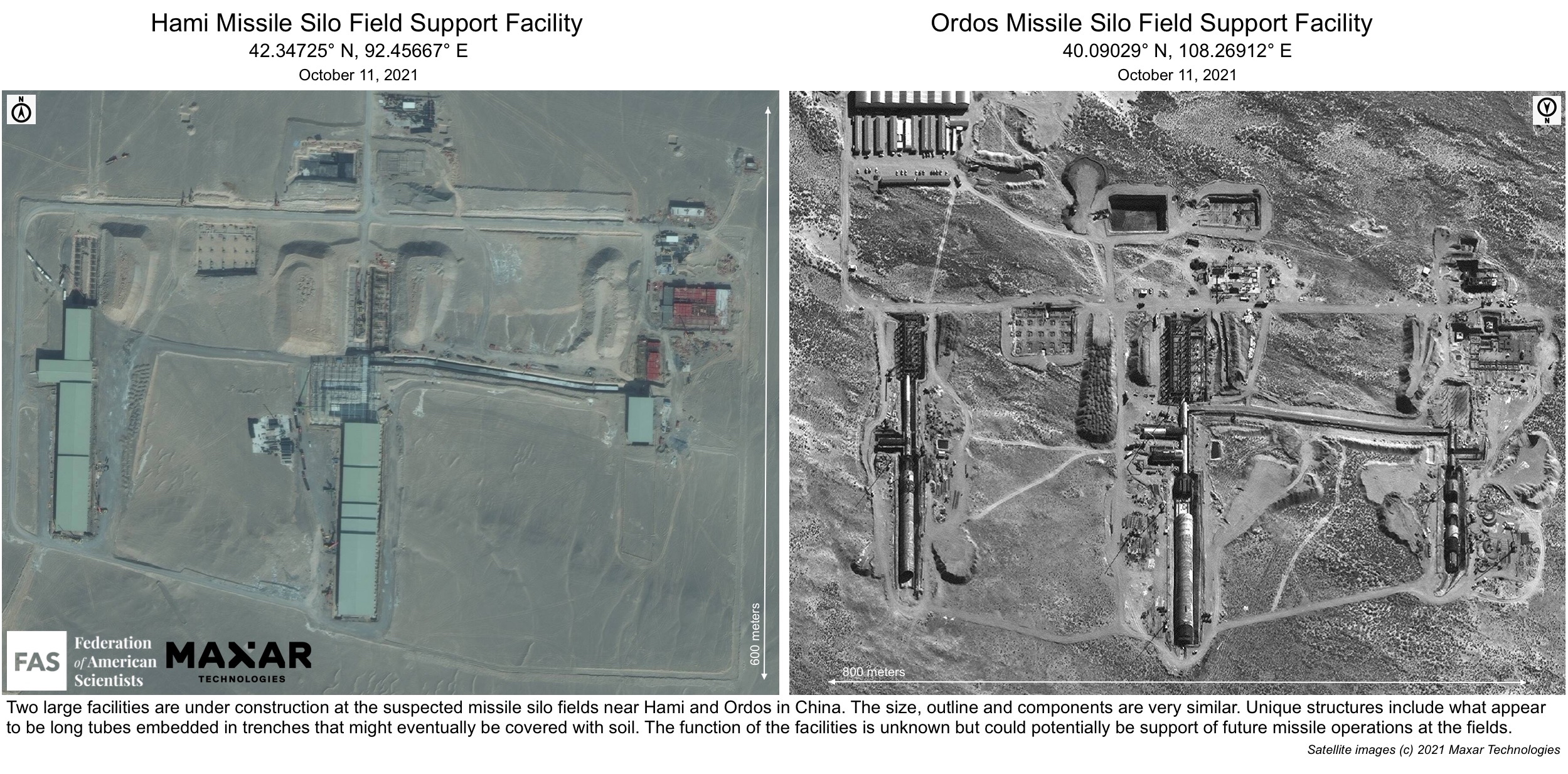
Large and unique support facilities are under construction at the suspected missile silo fields at Hami and Ordos. Click on image to view full size. Images © 2021 Maxar Technologies
Another unique facility so far seen only at Hami (42.2343°N, 92.897°E) includes a growing central complex in the mountains surrounded by what appear to be four tunnels into underground facilities. The tunnels are still under construction and show large amounts of excavation soil dumped nearby (see image below). The function of the facility is unknown but could potentially involve missile and/or warhead storage and management. Again, there is no evidence this is the case and is speculation at this point. The base-tunnel complex appears to be connected to the main missile silo grid via an underground cable. Sixty kilometers (37 miles) to the west (42.32163° N, 92.16282° E), at the other far side of the suspected missile field, is a similar facility with tunnels under construction.
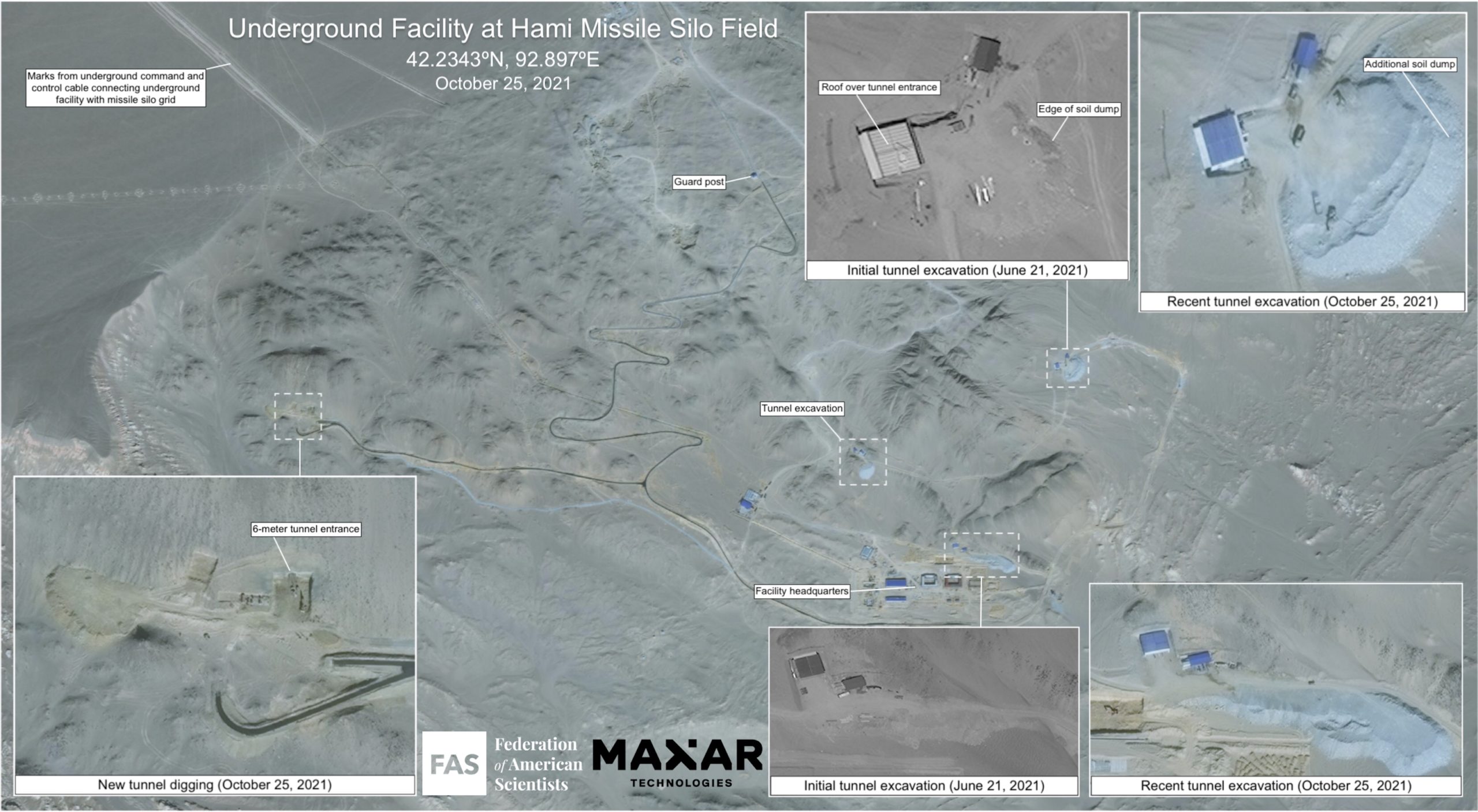
A large complex with several tunnels to underground facilities is under construction next to the suspected missile field at Hami. Click on image to view full size. Satellite images (©) 2021 Maxar Technologies.
There are also many other structures under construction that may be technical service facilities and launch control centers. Especially at Hami, we see construction of long lines of what may be powerlines intended to provide electrical power to the sprawling facilities. Finally, a number of larger and smaller construction camps and soil extraction sites are visible at all the suspected missile fields.
Interactive Maps
In order to help monitor and illustrate the construction of China’s suspected missile silo fields, the Federation of American Scientists has created an interactive map for each of the suspected missile silo fields at Yumen, Hami and Ordos (see example of Yumen below). Each map has a slider that allows the viewer to see how the construction of major facilities has progressed over time. These maps will be updated as construction continues. To access the maps, use these links:

FAS is building three interactive maps to enable the public to monitor the construction of China’s three suspected missile silo fields.
Concluding Thoughts
The similarities of the structures and the construction activities at the Jilantai training area and the three suspected missile silo fields under construction near Yuman, Hami, and Ordos all show what appear to be a clear connection to the PLARF’s missile program. Early on, this connection was most visible at Jilantai, where commercial satellite imagery captured telltale semi-circle silo wall structures, silo hatches, and even a potential missile loading operation. With construction progressing at the larger missile fields at Yumen, Hami and Ordos as described in this article, we see strong indications in the satellite images of what appear to be construction of missile silos and support facilities.
It is notable that at this time, no other inflatable air dome complexes on this scale have been spotted at other sites in China. Some sites (for example: 40.18064° N, 107.53670° E) appear to have similar (but much shorter) spacing patterns to those seen at the suspected silo fields; however, at higher imagery resolutions it becomes clear that those structures are not dome shelters or silos, but are in fact much smaller and very different structures for windmills. It is potentially possible that some windmills will be constructed in between the apparent silos; there is some evidence of that at Yumen. We note that some US ICBM silos are also in close proximity of windmills (for example: 40.8222, -104.0505); this does not appear to interfere with silo operations but can effect helicopter operations in the area.
Although we are increasingly confident that the facilities we describe are related to the PLARF’s missile program, it is also important to exercise caution and avoid confirmation bias––particularly if there are additional relevant sites out there that have not yet been spotted on commercial satellite imagery. Nor do we know what China plans to load into the apparent missile silos or how many of them will eventually be armed. The Chinese government has not yet officially confirmed or denied that the facilities are missile silos. But U.S. military officials appear to have confirmed that the reported missile silo fields are part of China’s nuclear modernization program. And based on the features we can examine on the new satellite images, we are increasingly confident that the facilities are indeed missile silos and support facilities under construction.
For China, this is an unprecedented nuclear buildup. We and others have remarked that it raises questions and uncertainty about China’s minimum nuclear deterrent and policies. On the other hand, even construction of large number of silos may not necessarily reflect a change in the basic role the Chinese leadership attributes to its nuclear forces. For example, China could potentially still retain its no-first-use policy. The apparent missile silo fields are still many years away from becoming fully operational and it remains to be seen how China will arm and operate them.
It is important that the buildup does not further increase nuclear competition and fuel worst-case planning in other nuclear weapon states, although we fear those are likely outcomes. These developments will feature prominently in the Biden administration’s ongoing Nuclear Posture Review and we urge the administration not to overreact but pursue conversations with the Chinese government to develop measures to reduce tension and increase transparency.
The reason is obvious: Although China has so far rejected limits on its nuclear forces by arguing that “Countries with the largest nuclear arsenals [Russia and the United States] have special and primary responsibilities in nuclear disarmament,” the size of the Chinese missile silo program – combined with the other elements of China’s nuclear modernization – could bring China into that category in the not too distant future. With approximately 300 apparent silos under construction – a number that exceeds the number of ICBM silos operated by Russia – and an additional 100-plus road-mobile ICBM launchers, China’s total ICBM force could potentially exceed that of either Russia and the United States in the foreseeable future.
This worrisome development may ironically also create new opportunities for arms control discussions and potential agreements. That is, if there is the political will to pursue them. With the review conference of the nuclear Non-Proliferation Treaty approaching early next year, this would seem to be a good time for the large nuclear powers to demonstrate that will.
Background information:
- China’s nuclear missile silo expansion: From minimum deterrence to medium deterrence (2021)
- China Is Building A Second Nuclear Missile Silo Field (2021)
- SIPRI Yearbook World Nuclear Forces (with China section), 2021
- China’s Expanding Missile Training Area: More Silos, Tunnels, and Support Facilities (2020)
- New Missile Silo And DF-41 Launchers Seen In Chinese Nuclear Missile Training (2019)
- Status of world nuclear forces
This publication was made possible by generous support from the John D. and Catherine T. MacArthur Foundation, the New Land Foundation, the Ploughshares Fund, and the Prospect Hill Foundation. The statements made and views expressed are solely the responsibility of the author.
NATO Nuclear Weapons Exercise Over Southern Europe

USAF personnel loading a B61 nuclear bomb trainer on an F-16 fighter-bomber at Aviano Air Base
NATO announced Monday that it had started its annual nuclear exercise code-named Steadfast Noon. The week-long exercise is taking place over Southern Europe and involves aircraft and personnel from 14 NATO countries.
According to the NATO statement, “Steadfast Noon involves training flights with dual-capable fighter jets, as well as conventional jets, backed by surveillance and refuelling aircraft. No live weapons are used. This exercise helps to ensure that NATO’s nuclear deterrent remains safe, secure and effective.”
The nuclear bases in southern Europe have received several upgrades during the past few years. This includes adding additional security perimeters to strengthen protection of the nuclear weapons stored at the bases. Two of these bases – Aviano in northeast Italy and Incirlik in southern Turkey, were upgraded over the past five years.
The second nuclear base in Italy – Ghedi near Brescia – that might be part of Italy’s hosting of this year’s Steadfast Noon exercise, is currently undergoing several important nuclear weapons related modernizations that are intended to serve the NATO nuclear strike mission for years.
Of the 14 nations involved, Dutch F-16s and German Tornadoes are operating out of Ghedi AB alongside Italian Tornados, while U.S. and Belgian F-16s and possibly Czech Gripen are operating out of Aviano AB.

The Steadfast Noon exercise appears to involve operations out of both Ghedi AB and Aviano AB
The timing of the Steadfast Noon exercise coincides with the meeting of the NATO ministers of defense later this week, although it is unclear if the timing is coincidental. NATO has greatly reduced (as has Russia) the number of non-strategic nuclear weapons in Europe since the Cold War. The remaining weapons were probably headed for withdrawal had it not been for Russia’s invasion of Ukraine in 2014. And with claims that Russia is increasing its non-strategic nuclear arsenal, NATO has since reemphasized the importance of the U.S. tactical nuclear weapons in Europe. During the Steadfast Noon exercise at Volkel Air Base in 2020, for example, the NATO Secretary General showed up at the base for a photo-op.

The USAF currently stores an estimated 100 nuclear bombs in Europe, down from 180 in 2010 and 480 in 2000. Over the past decade, restructuring and uncertainty about Turkey have reduced the inventory.
Ghedi: Nuclear Base Profile
NATO announced the Steadfast Noon is taking place over southern Europe but did not identify the main operating base. Steadfast Noon exercises are hosted by a different country each year. Last year it was hosted by the Netherlands and centered at Volkel AB. The reference to southern Europe implies this year’s Steadfast Noon is hosted by Italy and probably centered at Ghedi AB and Aviano AB is northern Italy (Aviano hosted in 2010 and 2013).
Ghedi AB is home to the Italian Air Force’s 6th Stormo wing, which is tasked to employ U.S. B61 bombs with PA-200 Tornado of the 102nd and 154th fighter-bomber squadrons. There are an estimated 15 B61 bombs stored in underground vaults at the base. The bombs are in the custody of the USAF’s 704th Munition Support Squadron (MUNSS), a 130-personnel strong security and maintenance unit embedded at the base.
Ghedi AB is currently undergoing significant upgrades to receive the new F-35A fighter-bomber next year, installing double-fence security perimeters, and having recently completed modernizing the Weapon Storage and Security System (WS3) and Alarm Communication and Display (AC&D) system. The contract for the WS3/AC&D work, which was awarded in September 2016, provided for sustainment upgrades to the WS3 cryptographic system used to encrypt WS3 alarm data, and will perform an AC&D system upgrade by replacing obsolete components and the buried cable. These upgrades are clearly visible on satellite images, as are a new “bunker building” under construction in the 704th MUNSS area along with the new Secure Transportation and Maintenance System (STMS) trucks (see images below).

Several nuclear weapons related upgrades are underway at Ghedi Air Base.
The new double-fence security perimeters around eight protective aircraft shelters (left side of image) as well as the former nuclear alert area (lower right side) are similar to the security upgrades previously completed at two other bases in southern Europe: Aviano and Incirlik air bases. The area inside the perimeters is commonly referred to as the NATO area, a reference to the NATO nuclear strike mission they support. In the 1990s, NATO installed a total of 11 underground vaults inside 11 protective aircraft shelters at Ghedi AB. Each vault can store up to four B61 bombs (normally only one or two bombs are present).
But there’s a mystery: The new security perimeters only surround 10 of the 11 shelters. One possibility is that the remaining vault in the 11th shelter is a training vault, or that the number of active vaults has been reduced. But a satellite image from April 2018 might provide a hint. The image appears to show the markings from the burying of the new AC&D cables that connect the vaults in the shelters with the monitoring and communications facilities at the base. By retracing the cables markings, a pattern emerges: the cables appear to connect exactly 11 shelters, including seven inside the new security perimeter. Moreover, the cables appear to form two loops, possibly so that damage to a cable in one spot won’t cut off communication with the vaults on the other side (see image below).

A satellite image appears to show which shelters are connected to the nuclear command and control system at Ghedi Air Base. Image: Google Earth, April 24, 2018.
There is another mystery: Several shelters connected to the apparent AC&D cable grid are located outside the new security perimeters (right side of image), and several shelter that do not appear to be connect to the grid are inside the perimeter (left side of image). Since survivability was one of the justifications for building vaults instead of a central weapons storage area, it would make sense that vaults would be scattered across the base. But the 11 vaults were completed at a time when there were many more nuclear bombs stored at Ghedi AB than today: over 40 bombs in 2000 compared with about 15 bombs today.
Perhaps the four vaults outside the perimeters are backup vaults that do not contain bombs under normal circumstances. All remaining weapons would be stored in the seven vaults inside the perimeters under normal circumstances. With a capability to store up to four B61 bombs each, even the five vaults inside the main security perimeter have more than enough capacity to store the 15 bombs currently estimated to be located at Ghedi AB.
Weapons And Capabilities
These upgrades at Ghedi AB are intended to support the NATO nuclear strike mission at the base for decades into the future. The F-35A, which will begin arriving at the base probably as early as in 2022, is significantly more capable than the Tornado aircraft it replaces.
Moreover, the B61-12 gravity bomb is about three times as accurate as the B61-3/-4 bombs current stored at the base. The increased accuracy is achieved with a new guided tail kit that will enable strike planners to hold at risk targets more effectively with the B61-12 than with the current B61 versions. Like the B61s currently at the base, the B61-12 is thought to have four selectable yield settings ranging from less than 1 kilotons to about 50 kilotons. But with the increased accuracy, a strike planner would be able to select a lower yield option for the attack and therefore create less radioactive fallout, or attack targets that currently require a higher-yield strategic bomb from a B-2 bomber.

The F-35A with the B61-12 “brings an entirely new strategic-level capability.”
The combination of the F-35A and B61-12 represent a significant improvement of the military capability of the NATO dual-capable aircraft posture in Europe. Following the final drop test from an F-35A in a few weeks ago, for example, the chief of the U.S. Air Force Air Combat Command’s strategic deterrence and nuclear integration division, Lt. Col Daniel Jackson, said that “Having a 5th Generation DCA fighter aircraft with this capability brings an entirely new strategic-level capability.” He explained further: “The B-2 bomber was the prominent nuclear capable stealth aircraft, but “Adding ‘nuclear capable’ to a 5th-Gen fighter that already brings several conventional-level capabilities to the table adds strategic-level implication to this jet.”
Additional information:
- United States Nuclear Weapons, 2021
- Tactical nuclear weapons, 2019
- Video Shows Earth-Penetrating Capability of B61-12 Nuclear Bomb
- Upgrades at US Nuclear Bases in Europe Acknowledge Security Risk
This publication was made possible by generous support from the John D. and Catherine T. MacArthur Foundation, the New Land Foundation, the Ploughshares Fund, and the Prospect Hill Foundation. The statements made and views expressed are solely the responsibility of the author.
After Trump Secrecy, Biden Administration Restores US Nuclear Weapons Transparency
[Updated] The Biden administration yesterday afternoon declassified the number of nuclear weapons the United States possesses. The act reverses the secrecy of the Trump administration, which denied release of the number for three years, and restores the nuclear transparency of the Obama administration.
FAS’ Steve Aftergood asked for this information in March 2021. We have still not received an official response.
Although a victory for nuclear transparency, the data shows only very limited nuclear weapons reductions in recent years – a stark reminder of the international nuclear climate, domestic policies, and that a lot more work is needed to reduce nuclear dangers.
Stockpile Numbers
According to the new data, the United States possessed a total of 3,750 nuclear warheads in the Department of Defense nuclear weapons stockpile as of September 2020. That number is only 50 warheads less than our estimate of 3,800 warheads from early this year.
The 3,750-warhead number is only 72 warheads fewer than in September 2017, the last number made available before the Trump administration closed the books.
That reduction is by any measure mediocre. In its announcement about the new stockpile numbers, the US Department of State highlights that the current stockpile of 3,750 warheads “represents an approximate 88 percent reduction in the stockpile from its maximum (31,255) at the end of fiscal year 1967, and an approximate 83 percent reduction from its level (22,217) when the Berlin Wall fell in late 1989.” While that is true and an amazing accomplishment, the fact remains that the vast majority of that reduction happened in two phases during the H.W. Bush and W. Bush administrations. Since 2008 the reduction has been slow and limited. The trend is that the reduction is decreasing and leveling out.
A peculiar revelation in the new data is that it shows that the stockpile increased by 20 warheads between September 2018 and September 2019 when Trump was in office. The increase is not explained but one possibility is that it reflects the production of the new W76-2 low-yield warhead that the Trump administration rushed into production in response to what it said was Russia’s plans for first-use of tactical nuclear weapons. The first W76-2 was produced in February 2019, NNSA was scheduled to deliver all the warheads by end of Fiscal Year 2019, but the W76-2 wasn’t completed until June 2020. Arkin and Kristensen reported in January 2020 that the first W76-2s had been deployed, which was later confirmed by the Pentagon.

It is possible (but unconfirmed) that the 20-warhead stockpile increase between 2018 and 2019 was caused by production of the Trump administration’s W76-2 low-yield Trident warhead. Image: NNSA.
The Trump administration’s brief increase of the stockpile is only the second time the United States has increased its number of nuclear warheads since the Cold War. The first time was in 1995-1996 when the Clinton administration increased the stockpile by 107 warheads. Since the W76-2 production continued after September 2019, the increase of 20 warheads should not be misinterpreted as being the final number of W76-2 warheads. After the 2018-2019 increase, the stockpile number dropped again by 55 warheads.
Update: Another possibility for the brief stockpile increase is that a small number of retired warheads were returned to the stockpile. This could potentially be B83-1 bombs that the Trump administration decided to retain instead of retiring with the fielding of the B61-12. It could potentially also be retired warheads brought in as feedstock for new weapon systems such as the planned nuclear sea-launched cruise missile. We just don’t know at this point.
Apparently, the nuclear modernization program supported by both Republicans and most Democrats, will result in significant additional reductions of the stockpile. In 2016, the former head of the Navy’s Strategic Systems Program, Vice Admiral Terry Benedict, said that once the W76-1 warhead production was completed by the end of FY2019, the W76-0 warheads that had not been converted to W76-1 would be retired and the total number of W76 warheads in the stockpile decrease by nearly 50%.
At the same time, the Pentagon’s Principal Deputy Assistant Secretary of Defense for Nuclear, Chemical, and Biological Defense Programs, Arthur T. Hopkins, told Congress that production and fielding of the B61-12 bomb would “result in a nearly 50 percent reduction in the number of nuclear gravity bombs in the stockpile” and “facilitate the removal from the stockpile of the last megaton-class weapon––the B83-1.”
Production of the W76-1 has now been completed but the promised reduction is not yet visible in the stockpile data – unless the excess warheads were gradually removed during the production years. The B61-12 has not been fielded yet so the gravity bomb reduction presumably will not happen until the mid-2020s.
Whatever the number of the additional stockpile reduction is, it is not planned to be nice to Kremlin and Beijing but because the US military doesn’t need the excess warheads anymore. Whether Russia and China’s nuclear increases will cause the Biden administration to change the plan outlined by Benedict and Hopkins will be decided by the Nuclear Posture Review.
Dismantlement Numbers
The data also shows that the United States as of September 2020 had about 2,000 retired warheads in storage awaiting dismantlement. Retired warheads are owned by the Department of Energy and not part of the DOD stockpile.
That number matches the available data. Former Secretary of State John Kerry said in 2015 that there were about 2,500 retired weapons left (as of September 2014). Since then, 1,432 warheads have been dismantled and an additional 967 weapons retired, which would leave just over 2,000 warheads in the dismantlement queue.

Approximately 2,000 retired warheads away dismantlement, including the B83 megaton gravity bomb. More are expected to follow during the next decade. Image: NNSA.
In our estimate from early this year, we thought the dismantlement queue had dropped to 1,750 warheads because we assumed the annual dismantlement rate had remained around 300. But as the data shows, both the Trump and Biden administrations reduced the number of warheads being dismantled per year.
In 2016, NNSA stated that it “will increase weapons dismantlement by 20 percent starting in FY 2018” and that the “accelerated rate will allow NNSA to complete the dismantlement commitment a year early, before the end of FY 2021.” NNSA reaffirmed in 2018, that all warheads retired prior to 2009 would be dismantled by end-FY 2022.
This pledge appears to have faded from recent documents after the 2018 Nuclear Posture Review was published. Instead, the annual number of warheads dismantled has decreased since FY 2018. Is it still the goal? Some of the warheads that should have been dismantled but are still with us reportedly include the W84 warheads from the ground-launched cruise missiles that were eliminated by the 1987 INF treaty and retired well before 2009.
Many of the warheads in the current dismantlement queue were retired after 2009. At the current rate of 184 warheads dismantled per year, it will take more than a decade to dismantle the current backlog. Once the excess W76s and old gravity bombs enter the queue, it will take even longer.
In Context
We commend the Biden administration for reversing the Trump administration’s shortsighted and counterproductive nuclear secrecy and restore transparency to the US nuclear weapons stockpile. This decision is a heavy lifting at a time when so-called Great Power Competition is overtaking defense and arms control analysis. The Federation of American Scientists has for years advocated for increased transparency of nuclear arsenals and have worked to provide that through our estimates of nuclear weapons arsenals.
Although the recent reductions shown in stockpile and dismantlement data are modest, to put it mildly, we believe declassification is the right decision because making the record public will help US diplomats make the case that the United States is continuing its efforts to reduce nuclear arsenals and increase nuclear transparency. This is especially important in the context of the upcoming January 2022 Review Conference for the Treaty on the Non-Proliferation of Nuclear Weapons. Dissatisfaction with the lackluster disarmament progress – and a belief that the nuclear-armed states are walking back decades of arms control progress with their excessive nuclear modernization programs and dangerous changes to operations and strategy – have fueled support for the Treaty on the Prohibition of Nuclear Weapons (TPNW).
The decision to disclose the stockpile and dismantlement data will also enhance the US credibility when urging other nuclear-armed states to be more transparent about their arsenals. We have no illusions that Russia or China will follow the example in the short term, but keeping the US numbers secret will certainly not help. And over time, the disclosure can help shape discussions and norms about nuclear transparency to shape future decisions. This is also important because the Trump secrecy recently provided cover for the United Kingdom to reduce information about its nuclear forces.
Hardliners will no doubt criticize the Biden administration’s decision to disclose the stockpile and dismantlement data. They will argue that past nuclear transparency has not given the United States any leverage, that nuclear-armed states previously have not followed the example, and it that makes the United States look naive – even irresponsible – in view of Russia and China’s nuclear secrecy and build-up.
On the contrary: without transparency the United States has no case. Past transparency has given the United States leverage to defend its record and promote its policies in international fora, dismiss rumors and exaggerations about its nuclear arsenal, and publicly and privately challenge other nuclear-armed states’ secrecy and promote nuclear transparency. And since the disclosure does not reveal any critical national security information, there is no reason to classify the stockpile and dismantlement data.
Hardliners obviously will have to acknowledge that the data shows that there has been no unilateral US disarmament but only a very modest reduction in recent years. And although there appear to be additional unilateral reductions built into the modernization programs, those are actually programs that have been supported and defended by the hardliners.
Now it is up to the Biden administration’s Nuclear Posture Review to articulate how and to what extent those plans support and strengthen US national security and nonproliferation objectives. Arms control obviously will have to be part of that assessment. The declassified stockpile and dismantlement data will help make the case that additional reductions are both needed and possible.
Background Information:
- US Department of State, Transparency in the U.S. Nuclear Weapons Stockpile, Fact Sheet, October 5, 2021
- “United States Nuclear Forces, 2021,” FAS Nuclear Notebook, Bulletin of the Atomic Scientists, March/April 2021
- “Pentagon Slams Door On Nuclear Weapons Stockpile Transparency,” FAS Strategic Security Blog, April 17, 2019
- Status of World Nuclear Forces, Federation of American Scientists global arsenal page
This article was made possible by generous support from the John D. and Catherine T. MacArthur Foundation, the New Land Foundation, the Prospect Hill Foundation, and the Ploughshares Fund. The statements made and views expressed are solely the responsibility of the authors.
Biden, You Should Be Aware That Your Submarine Deal Has Costs
For more than a decade, Washington has struggled to prioritize what it calls great power competition with China — a contest for military and political dominance. President Biden has been working hard to make the pivot to Asia that his two predecessors never quite managed.
The landmark defense pact with Australia and Britain, AUKUS, that Mr. Biden announced this month is a major step to making that pivot a reality. Under the agreement, Australia will explore hosting U.S. bombers on its territory, gain access to advanced missiles and receive nuclear propulsion technology to power a new fleet of submarines.
